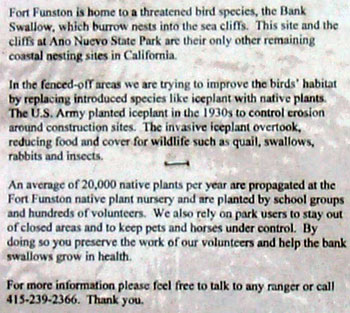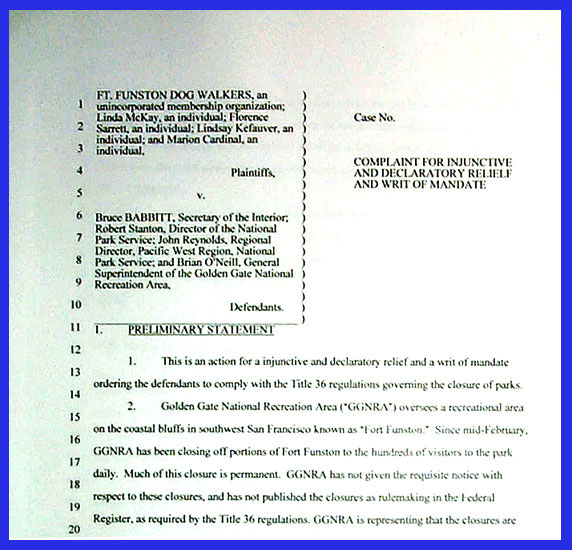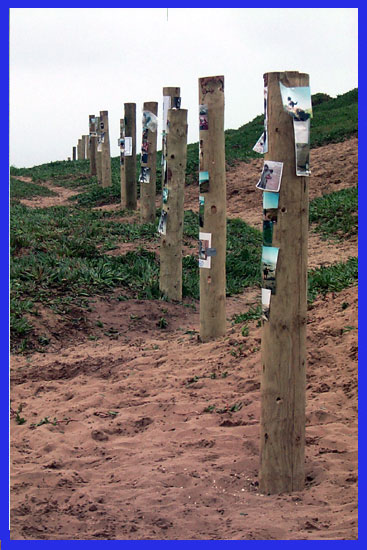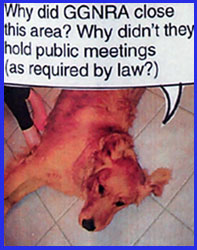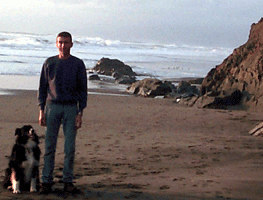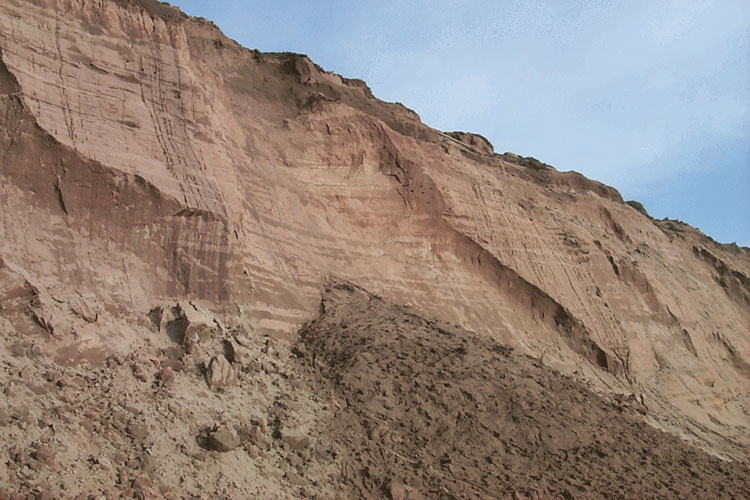Fort
Funston Forum
Friday,
October 6, 2000
to
Front
Page Second
Section 
 to
Court Report
to
Court Report
Quail Questions
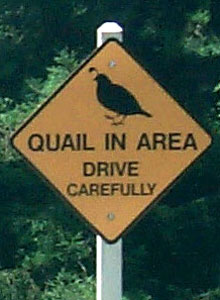
Quail Resolution ApprovedThe San Francisco Board of Supervisors at their Monday, July 10, 2000 meeting approved a: Resolution urging the Recreation and Park Department, the Public Utilities Commission, and other City Departments to give the utmost cooperation and support to the "Save the Quail Campaign" without killing other animals, and designating the California Quail as the official bird of the City and County of San Francisco. |
Board
of Supervisors Agenda, San Francisco
Monday, July 10, 2000 For adoption
without committee reference. These measures are introduced for adoption without
committee reference. A unanimous vote is required for adoption of a
resolution today. Any Supervisor may require any resolution to go to committee.
Items 35 through 46..........
37. 001215 [Save the Quail Campaign] Supervisor Katz
Resolution urging the Recreation and Park Department, the Public Utilities
Commission, and other City Departments to give the utmost cooperation and
support to the "Save the Quail Campaign" without killing other animals, and
designating the California Quail as the official bird of the City and County
of San Francisco.
6/26/2000, REFERRED FOR ADOPTION WITHOUT COMMITTEE REFERENCE AGENDA AT
THE NEXT BOARD MEETING. Question: Shall this Resolution be ADOPTED?
(emphasis added)
City
Bird Waiting in the Wings
June 26, 2000 -- San Francisco Examiner
Kathleen Sullivan
" ..... But no cats, racoons or skunks - or people with off-leash
dogs - are expected to show up to protest the bird's proposed honor at City
Hall."
(emphasis added)
Supervisor
Presses Cause Of Quail in City Parks
June 24, 2000 - San Francisco Chronicle
"The commission forwarded its proposal to the Board of Supervisors
last month, after the pro-quail Golden Gate chapter of the Audubon Society
and the pro-cat San Francisco Society for the Prevention of Cruelty to Animals
agreed on a joint plan. The SPCA had earlier objected to the quail plan
because it feared the project would entail killing the feral cats that live
in Golden Gate Park. For years, the SPCA has been working to cut the feral
cat population by neutering and spaying such cats. As approved by the commission,
the plan makes no reference to removing cats."
(emphasis added)
"Save
the Quail" Campaign
Golden Gate Audubon Society
"As the breeding season approached quail sightings continued to come
in from the Presidio and Strybing Arboretum in Golden Gate Park.
Many people reported seeing males and females paired for nesting. A May 7,
check of the habitat restoration area at Fort Funston found that the
quail had returned. "Through the article we learned of quail populations
in the San Francisco Golf Club, The Olympic Club, and there
were also reports of quail near Mt. Davidson, Glen Canyon Park,
and Diamond Heights. One quail was seen near Stern Grove and
was reported by numerous observers. Other reports were from near the Polo
Field, and the Oak Woodlands in Golden Gate Park. The two most
unusual reports were from the Mission District and Russian Hill."
(emphasis added)
California
Quail Have Refuge in Presidio:
June 20, 2000 - Quail Unlimited
Explains new traffic signs' significance:
"The signs are to notify and encourage visitors to drive slowly in sensitive
areas, keep their pets on a leash and avoid feeding animals that prey
on quail." ... "Quail chicks, in recent years, have hatched in mid-June
on the Presidio. Shortly after hatching, the young leave their nest and
feed on their own, which makes the chicks more susceptible to an early death
than other species which stay in their nest." ... "The quail's
nests are usually well hidden."
(emphasis added)
Presidio
Takes Quail Under Its Wing
June 29, 2000 - San Francisco Chronicle
Kelly St. John
"At the turn of the century, 1,200 quail nested in Golden Gate Park,
but loss of habitat, predators and humans have cut those numbers to about
a dozen. Fort Funston is the other area in San Francisco where quail are
found. On July 10, the Board of Supervisors is scheduled to vote on a
plan, sponsored by Supervisor Leslie Katz, to name the California quail San
Francisco's official city bird and to protect the birds by restoring their
native habitat in the city's parks. City agencies would be asked to support
the Golden Gate Audubon Society's "Save the Quail" campaign, which promotes
habitat preservation and education of the public about the quail's plight"
(emphasis added)
Endorsing
the "Save the Quail" Campaign
Resolution No. 009-00-COE May 15, 2000
Commission on the Environment, City and County of San Francisco
"WHEREAS, The California Quail is significant to our cultural history
as well as our natural heritage, as quail were an important food source
to the Ohlone people and to the early settlers; and, WHEREAS, ....."
(emphasis added)
S.F.
Panel OKs Plan to Save Park Quail
May 16, 2000 - San Francisco Chronicle
by Tom Zoellner
"The 'Save the Quails ' plan to rehabilitate the park's dwindling quail
habitat goes next to the Board of Supervisors after being modified with
the phrase, ''without
killing any animals.'' A sentence calling for the removal of ''invasive,
non-native species'' was also amended to refer only to plants, ivy and other
vegetation that threatens quail habitats. Cat lovers, led by the Society
for the Prevention of Cruelty to Animals, had worried that saving the quail
was a backdoor excuse to eradicate the park's population of stray cats, which
feed on birds, including quail."
(emphasis added)
Golden
Gate Park Losing its Quail
Jan. 13, 2000 - San Francisco Examiner
"Statewide, the quail population is in good shape, said Department
of Fish and Game biologist Sam Blankenship. The population decline in Golden
Gate Park may be hard to arrest, because "it's difficult for an isolated area
like that to repopulate. Quail (populations) boom and bust, and there's no
ebb and flow from other population areas." California hunters bagged 500,374
quail during the staggered hunting seasons, which run from the last week
in September until Jan. 10."
(emphasis added)
California's
Upland Game Birds
Department of Fish and Game: California Quail.
"These quail are found in every county of the State.
They are usually associated with brushy vegetation in combination with more
open weedy or grassy habitats and available water supplies. They avoid heavy
forest and dense chaparral, although trees with dense foliage may be used
for roosting. The California quail is also known as the valley quail, and
became the official California State bird in 1931."
(emphasis added)
The
California Quail
website - by Dave Riensche
"Of our three species
of Quail, the California is the most wide spread."
(emphasis added)
A
Quail Quandary
July 8, 2000 - San Francisco Chronicle
by Glen Martin
"The sole bright spot, said Hopkins, is
Fort Funston, where habitat restoration projects have resulted in a modest
resurgence in quail numbers. Hopkins said much of the bird's decline can
be attributed to habitat destruction. ``Our goal is to increase suitable
habitat in areas where quail can live, and possibly conduct reintroduction
programs if necessary,'' he said."
(emphasis added)
Quail
Questions and Answers
Virginia Dept. of Game & Inland Fisheries
"Q. Why doesn't the Game Department stock pen-raised quail to increase
population levels? A. From 1922 through 1958, more than 100,000 pen-raised
quail were raised at Department Game Farms and released throughout the state.
Wildlife managers began to notice that areas where large numbers of quail
had been released seemed to have no more birds than unstocked areas. Soon
it was the general consensus that stocking pen-reared quail into unoccupied
areas did not result in the establishment of new populations, usually because
habitat conditions were sub-optimal. Stocking birds into favorable habitat
was deemed unnecessary because native birds would colonize these areas. Pen-raised
quail usually survive poorly because they are less wary and fly slower than
wild birds, making them very susceptible to predation. There is also concern
that the release of pen-raised quail can introduce diseases into the wild
population and increase mortality rates by attracting predators to the release
site. As a result, the Department recommends habitat improvements as the
best way to increase quail numbers on a landowner's property. Stocking pen-raised
quail into habitats where native quail can not survive is a waste of valuable
resources that could be used for legitimate conservation efforts."
(emphasis added)
Ecology
& Management of the Northern Bobwhite
Mississippi State University Extension Service
"Annual burning of cutovers and open pine forests, along with
associated grazing of livestock and cropping, provided the right patchwork
or "mosaic" of early successional habitats that quail require..." ........
"Researchers and other professionals learned
that bobwhites require patchy habitats that provide a mix of bare ground,
seeds, and insects and vegetation for nesting, brood-rearing cover, and protection
from predators."
(emphasis added)
All
About Nature: Animal Printouts
EnchantedLearning.com Hey
KIDS!
Color a quail drawing -- with Crayons or Paint!
"In addition to printing the animals, you can copy a printout and paste
it into a painting program (like Paint) and color the animal there."
... "The quail's call sounds like chi--CA-go, where the middle sound
(CA) is higher in pitch."
(emphasis added)
California
Quail
GeoZoo:
" Like many of their relatives, California quails explode in flight
when surprised on the ground. (They have been timed at thirty-eight
to fifty-eight miles per hour.) But, unlike bobwhites, they don’t all
fly at once, and they scatter in different directions. After alighting, they
run swiftly. (They have been timed running at twelve miles per hour.)"
(emphasis added)
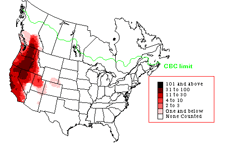
California
Quail Breeding Distribution Map
Sauer, J. R., J. E. Hines, I. Thomas, J. Fallon, and G.
Gough. 1999.
The North American Breeding Bird Survey, I
Results and Analysis 1966 - 1998. Version 98.1,
USGS Patuxent Wildlife Research Center, Laurel, MD
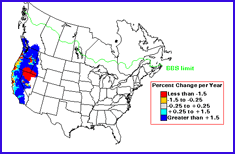
California
Quail Trend Distribution Map
Sauer, J. R., J. E. Hines, I. Thomas, J. Fallon, and
G. Gough. 1999.
The North American Breeding Bird Survey,
Results and Analysis 1966 - 1998. Version 98.1,
USGS Patuxent Wildlife Research Center, Laurel, MD

The
California Quail
by A. Starker Leopold
University of California Press 1985
The definitive reference book.
Wildlife
Terms
North Carolina State University, North Carolina A & T State
University,
US Department of Agriculture, and local governments.
The San Francisco Society for the Prevention
of Cruelty to Animals
2500 16th Street * San Francisco, CA * 94103-4213 * (415) 554-3000 *
www.sfspca.org
============
Statement to the Commission
on the Environment:
Proposed Resolution to Target "Non-Native" Species
May 15, 2000
The San Francisco SPCA believes all animals, whether wild or domestic, are equally entitled to our respect, concern, and compassion. We also believe each is entitled to a fair share of the natural resources necessary to preserve their well-being. We recognize that in some cases the needs of one species may conflict with that of another. In weighing these different interests, we feel that balance and fairness are essential for a just resolution. Where the loss to one species is great, the corresponding need should be equally compelling. And no species should be asked to give up vital habitat and essential natural resources without such a demonstration. To burden one creature without benefiting another is, in our view, misguided and wrong. And whatever the need, killing is never an appropriate solution, even when the corresponding need appears compelling
Before the Commission on the Environment is a proposed resolution endorsing a "Save the Quail" campaign. It claims that the quail is native to San Francisco, was an important food source to early settlers, is declining in population, and blames "introduction of invasive non-native species" for the decline. The proposed resolution also calls on City government to develop and implement a quail recovery and management plan. The San Francisco SPCA objects to the proposed resolution for the following reasons:
The proposed resolution lacks a balanced perspective.
Scientific studies of the actual nature of cat and other predation in City
parks were not included, animal welfare organizations were not consulted prior
to the drafting of the resolution, and true reasons for quail decline are
ignored.
The proposed resolution will likely be carried
out through trapping and slaughter of innocent cats, skunks and other animals;
by denying adequate opportunities for dogs and dog lovers to exercise; and
by limiting recreation opportunities for scores of other park users.
The proposal will not result in increasing quail populations. At the same time, taxpayer money will have been wasted, cats and skunks will have been killed, recreation opportunities limited, and the clear-cutting of trees and plants carried out.
Although carefully worded to appear innocuous, the proposed resolution is merely a rewording of both a 1993 plan to round up and kill feral cats in City parks and language in the draft Sustainability Plan which apparently saw nothing amiss with ranking "irresponsible pet owners" as a major threat to biodiversity -- a point that defies fact and logic.
In 1997, the Board of Supervisors voted unanimously to remove that language from the Sustainability Plan before it was approved as a document for San Francisco's future. And following months of research and public testimony, an equally one-side vote by the Commission on Animal Control and Welfare thoroughly rejected the 1993 call for killing cats in City parks.
Unless the Commission is concluding that the San Francisco Board of Supervisors, the San Francisco Commission on Animal Control and Welfare, the San Francisco park studies by biologist Robert Berg, and predation studies on four continents (13 studies in Europe, 12 in North America, 9 in Australia, and 1 in Africa) are all wrong, cats and other unwanted animals should not be unfairly implicated in any perceived decimation of local wildlife.
Accordingly, on
behalf of the 91,249 members of The San Francisco SPCA, we ask that the Commission
reject the proposed backward-thinking resolution, and in its place, reaffirm
San Francisco as a City that looks to the future -- a future of compassion
and sensitivity for all life.
1. The Proposed Resolution Is Internally and Hopelessly Flawed. [1]
Golden Gate Park is a man-made construct; it does not fit into any natural type of ecosystem. From an ecological standpoint, there are plants from all over the world in "unnatural" assemblages. To suggest that feral cats or other "introduced" species in the park are upsetting the natural ecosystem is nonsensical since the park itself is not part of the "natural" ecosystem (the original ecosystem consisted of coastal strand vegetation and wildlife near the ocean and dune ecosystems inland covering most of what today comprises the avenues.)
At the same time, the quail in Golden Gate Park and elsewhere in San Francisco is not native. Quail were also "introduced" into this and other City parks (A study by biologist Dr. Robert Berg indicates that the park quail are what is likely left of birds released in the recent past from a time when raising baby quail from eggs in incubators was a popular children's activity, and parents released the quail when they became adults and the children lost interest). Regardless of when and where the quail came from, the area that comprises Golden Gate Park, either now or before the park was constructed, is not habitat that is conducive to the maintenance of a healthy breeding quail population. In order for a population of quail to exist in a biologically healthy manner the following attributes must be present: First, the area must be large enough to support a population that in itself contains enough individuals to maintain genetic diversity (i.e., inbreeding must be kept to a minimum). Second, there must be genetic continuity with other members of the species (immigration), which is one of the ways genetic diversity within the population is maintained. Third, the habitat must provide the species in question with available foraging and breeding sites as well as refuge, patchy environments, dispersal barriers, and alternative food sources.
The Park, as it pertains to the quail, falls short in all the aspects listed above. As a result, it should not be surprising that they do not fare well. Due to the policy of removing such vegetation to discourage the homeless from taking refuge there, the quail are deprived of the underbrush they desire for safe foraging and flight. True quail habitat consists of scrublands and chapparel ecosystems, while Golden Gate Park offers neither.
To also suggest that Lincoln Park, Lake Merced, Harding Park, Stern Grove and Pine Lake Park are any better is also wishful thinking. These areas, even if they contained their original assemblages of plants and animals, are much too small to support viable quail populations in any meaningful ecological or evolutionary sense. In short, even a pristine San Francisco is not conducive to a healthy quail population. Particularly as it relates to the parks noted in the resolution, it is the encroachment of the urban areas and lack of habitat which are responsible for quail decline. The fact that they cannot sustain a viable population speaks more to the unsuitability of City parks and the City proper as habitat, than to some overwhelming pressure from "invasive non-native species."
Even if all cats, skunks, and other so-called "invasive non-native species" were removed from City parks, if dog walking was prohibited, and if our parks became fenced compounds, the quail would eventually suffer local extinction for the reasons stated above. As a result, the killing of innocent animals, the thwarting of recreation opportunities for San Francisco residents with or without dogs, cutting down trees and removing plants will be done in vain, and at great cost, without achieving the desired results.
2. The Proposed Resolution Seeks Scapegoats not Solutions.
In Golden Gate Park, and throughout our City, the factors that account for the disappearance of the quail and other wildlife/birds are habitat loss, pollution, removal of shrubbery, use of pesticides and inclement weather changes.
The reasons for this are well-documented. As human development continues in our already crowded City, available habitat for wildlife is carved up into smaller and smaller pieces. Under such circumstances, harsh winters or long periods of drought can easily drive down remaining quail populations.
Pesticides are also recognized as a major culprit in bird decline -- particularly the effect of toxic lawn care products. Insecticides, herbicides, fungicides, and rodenticides are routinely used in City parks. Indeed, poisoning as a result of everyday use of pesticides has become so widespread that biologists term the phenomenon "lawn-care syndrome." Other practices, such as removal of low growing shrubbery, tree trimming, and the lack of adequate maintenance at many City parks will also impact on birds and other wildlife.
City officials have also recognized and acknowledged that cats are not responsible for bird decline in San Francisco. The Board of Supervisors' Commission on Animal Control and Welfare put a stop to a proposed round up and kill plan for feral cats in Golden Gate Park after extensive research and public testimony demonstrated a clear lack of evidence that cats were impacting quail and other birds. The Board of Supervisors also removed language from the City's Sustainability Plan targeting feral cats as a threat to biodiversity -- a decision reached after all sides were heard, a consideration not extended by the Department of the Environment in the drafting of the original document.
In addition, aggressive spay/neuter and other humane community-based programs have markedly decreased the cat population in the park. In one location, a colony was reduced from 85 cats to two, without a single cat being killed. Since the cat population is declining, shouldn't the quail population be increasing? If the quail population is declining at the same time that the cat population is declining, this fact points to some other causal variable. It is, notably, of no mere coincidence that the observed quail decline matches the removal of low-growing shrubbery and use of poisons in City parks.
Given the available evidence to the opposite, we believe it is both incorrect and inappropriate to speculate that "invasive non-native species" are a significant cause for the decline of any species in San Francisco parks. In fact, unless we are going to conclude that the San Francisco Board of Supervisors, the San Francisco Commission on Animal Control and Welfare, the Golden Gate Park studies by biologist Robert Berg, and predation studies on four continents (13 studies in Europe, 12 in North America, nine in Australia, and one in Africa) are all wrong, cats and other animals should not be unfairly implicated in any perceived decimation of local wildlife.
3. The Proposed Resolution is Anti-People.
Golden Gate Park is a great urban park, not a pristine native environment that mimics some mythical state of nature that existed in 1491, the year before Christopher Columbus set sail, or before the City was established and populated (indeed the park itself is a man-made construct). Our other parks are also surrounded by a heavily populated urban environment. And it is our City parks' recreational value that is of the utmost importance to San Franciscans. The parks serve the outdoor recreation needs of the people of this metropolitan region and their objective should remain to expand to the maximum extent possible the outdoor recreation opportunities available to our citizens.
Now, the Commission on the Environment is being asked whether our parks are going to be recreation areas -- nestled as they are on the edge of a major metropolitan area -- or whether they should be turned into pristine native environments, inaccessible to the bulk of individuals who use them now.
If the native habitat projects proposed under the current resolution succeed and begin to flourish and support new wildlife populations, will fences be erected and moved further and further, taking more and more space away from traditional recreational uses -- dictating that more cats should be rounded up, extricated and killed? That joggers and dogs must also keep out? That kids and families picnicking would no longer be welcome in these locations? And that the scores of others who use our parks -- Frisbee players, artists, joggers, skateboarders, bicycle enthusiasts, families and Tai Chi practitioners -- must also keep away? Will our parks be turned into native sand dunes, or worse, into fenced compounds -- off limits to all but the nativist stewards self-assigned to keep the rest of us out?
In January 2000, the following commentary appeared in the San Francisco Chronicle: "In the late 1980s and early 1990s [Golden Gate] park was invaded by an ever-burgeoning population of "homeless" people. Wherever there was thick brush they made camp, dragging in mattresses and creating huge piles of rubbish. To circumvent these hidden encampments, San Francisco Park and Recreation eliminated most of the thickets, heavy brush and dense foliage, which was also habitat imperative for survival of [the quail]."
The comment further blamed "habitat loss -- squatting by humans" and the Park and Recreation department response as the "primary cause" for the quail's decline. If this is true, will the Commission also endorse a full-scale effort to kick the homeless out of the park?
4. The Proposed Resolution Requires Killing Animals.
While presented as an innocuous measure, the lack of a balanced perspective in the proposed resolution is evident. And the proposed resolution is clear: It calls for the elimination of feral cat colonies, skunks, dogs running with their owners, and perhaps even people from the park. As to feral cats, the only way such a directive could be carried out is through the mass trapping and slaughter of innocent animals.
At The San Francisco SPCA, we wish every cat living today were a cherished companion. And we are working along with thousands of San Franciscans to achieve this goal by humanely trapping, spaying or neutering, and socializing feral cats for adoption. But many are too wild to adapt to a human home. For these cats, the humane response is to return them to their colonies, where they are watched over by compassionate caregivers and allowed to live out their natural lives without producing new generations of homeless cats.
The resolution's preoccupation with feral cats and other "non-native" animals deemed unworthy, however, is evident and pervasive, even if carefully masked. Not surprising since prejudice and bias against the animals closest to us -- cats and dogs who are our daily companions -- is nothing new. The proposed resolution, although carefully worded to appear innocuous, mimics the original call for elimination of cats from these parks by the same proponents in 1993, which was thoroughly rejected by the San Francisco Commission on Animal Control and Welfare.
This resolution also comes from the same proponents who developed the same call in the draft Sustainability Plan, which apparently saw nothing amiss with ranking "irresponsible pet owners" (along with urban development and industrial pollution) as a major threat to biodiversity -- a point of view that has no basis in fact or logic. Had any animal groups been represented among the 400 people from City departments, private businesses and nonprofit organizations included in drafting the Sustainability Plan, this document might have reflected the proven benefits to human health, happiness and social well-being that companion animals provide
It took the thoughtful actions by unanimous vote of the Board of Supervisors to remove that language from the final Plan before it was approved as a document for San Francisco's future -- a future of compassion and sensitivity for all life in keeping with the values of St. Francis.
5. The Proposed Resolution Endorses the View of "Garbage" Animals.
The proposed resolution is based on a troubling belief: value comes from lineage, and worth as a species stems from being here first. The belief that some species of animals are worth more than others because they were here first is backward-thinking and shortsighted. But it is hardly surprising. The call for extermination of animals in the name of protecting others deemed more worthy by some arbitrary standard is not new. "Cats kill birds, so we must kill cats." This is the banner under which proponents of the proposed resolution have long rallied to label cats as the "pests" of our cities and "invasive non-native" intruders in our parks and countryside. But cats aren't the only ones to be targeted for slaughter in the name of protecting other species or reserving "native" habitats. They have been joined at different times and in different places by red foxes, gulls, cowbirds, sea lions, coyotes, mountain lions, ravens, skunks, raccoons, wild horses... the list goes on. Referred to as "garbage animals," "alien" species, "weeds," and "vermin," these creatures have become scapegoats for the massive habitat destruction, environmental degradation, and species extinction caused by one species and one species alone: Humans.
For nativists, the point is clear: the lives of these animals don't count, and therefore they can and should be eliminated to protect more important species and to preserve "natural" environments. Had we honored and preserved life, had we treated all animals -- cats, birds and every other creature who shares our planet -- with the respect they each deserve, we might have spared many of the species now lost forever.
To us, there are no "garbage animals" and slaughter and death aren't the tools we need to preserve life. To do that -- to preserve the life of all animals -- we believe we must honor and preserve the life of each.
6. Conclusion
The San Francisco SPCA believes quail are deserving of our protection, not because they were "food" for a culture that existed 150 years ago.[2] Nor because someone claims that they were here before European contact. Nor do we believe that killing other animals today will do justice to any heritage of the past. In rejecting the proposed resolution, a resolution steeped in the shortsightedness and prejudice of the past, the Commission will be sending a powerful message -- a message that says killing is not an acceptable management tool for us to use as stewards of our nation's animals. Whether our challenges involve protecting wildlife, preserving species, or dealing with pet overpopulation, we have the power to build a new consensus that rejects killing as a method for achieving results. And we can look forward to a time when things like trapping, hunting, and slaughter are viewed as cruel aberrations of the past.
Instead of killing animals in a misguided attempt to "restore" the "purity" of some mythical time, we look forward to the day when every creature -- from the feral cat in Florida to the grizzly bear in Alaska -- will be respected and cherished... And where every individual life will be protected and revered.
[1] The following section was excerpted from a 1993 study by Dr. Robert Berg, the only independent biological study that examined the quail and other wildlife in San Francisco parks.
[2]The proposed resolution indicates that quail is "significant to our cultural history" "as quail were an important food source to the Ohlone people and to the early settlers." To kill an animal now, because settlers used to kill quail a century ago would simply be ludicrous if it were not so disturbing.
Note:
The statement above was written before the Quail Resolution was changed
to specify that no animals would be killed, but the points are all still
quite relevant to the current situation.
Permission to reprint:
Thank you for contacting The San Francisco SPCA about our recent quail statement
at the San Francisco Commission on the Environment. We appreciate your interest
and welcome you to put it on your website. Thank you again, and best of
luck in all your humane endeavors. -
SF SPCA July 7, 2000
Whale Wafting Season

Recently, a whale came to rest on the northern end of the beach at Fort Funston,
near the Great Highway.
We don't have information yet about the type of whale, cause of death, just
the burning question:
What do you do with a dead whale on the beach?

Roping it off is a first step (but dogs pretend they can't read the instructions on the yellow tape to stay back!)
But as the odor of decaying marine mammal wafts further and further up the beach, the burning question remains.
Burning the remains in question, however, wouldn't work. This problem has been faced countless times by humans, who have tried everything from explosives to towing out to sea to burying to quartering, often without success. Here are three interesting efforts from whale disposal history:
note: While the disposal issue is humorous (the whale is quite dead and it's an engineering challenge) the question of why many more grey whales (we don't know yet if this is a grey) are washing up dead on our shores is troubling, and as we discover more on this and other whale beachings, more information will follow.)
 The
Infamous Exploding Whale (Dave
Barry piece plus QuickTime video -- it didn't go as planned!)
The
Infamous Exploding Whale (Dave
Barry piece plus QuickTime video -- it didn't go as planned!)
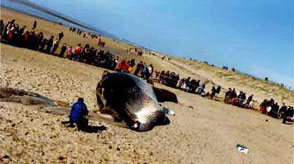 40-ton Dead Whale Beached Herself in Normandy (also available en
français)
40-ton Dead Whale Beached Herself in Normandy (also available en
français)
Burying the humpback of Stinson Beach - Point Reyes Light article
? OK, if you're so clever -- how would you deal with this? Any suggestions?
[ from Monday July 3, 2000 ]
Firecrackers on the Beach -- Threat to Bank Swallows?
 On
Sunday, there seemed to be almost no bank swallows at their main colony site.
Ordinarily, there would be several dozen flitting around and zipping in and
out of their burrows in the cliff.
On
Sunday, there seemed to be almost no bank swallows at their main colony site.
Ordinarily, there would be several dozen flitting around and zipping in and
out of their burrows in the cliff.
On closer inspection, there was a large amount of debris from fireworks on the beach nearby -- between the main colony and the "Gunmount", as well as just north of the northernmost bank swallow burrows and signs near the Great Highway.
Fireworks are and have been known to be a danger to the birds. In the past, the swallows seem to have abandoned their site after such a scare. We don't know if that has happened here, but can't help wonder why so much time and money were put into fencing off ten acres far from the burrows, while known dangers such as firecrackers are not prevented. Also, in the northern area of the beach there are still fenceposts sitting right above the burrows, which have been a convenient spot from which kestrels can swoop in on bank swallow hatchlings. The Park Service claims to have installed chicken wire on these posts to keep these predators away, but it doesn't appear to have been done or maintained in several areas.
The National Park Service's credibility is eroded by the lack of attention to two known threats to the birds, while at the same time using unproven claims of a threat from dogs and hikers to discontinue recreational use of park lands.
- Michael B. Goldstein, Editor
UPDATE: There seemed to be more bank swallows on Monday, though fewer than average. And apparently the Park Service does plan to guard the site tonight, as it has in the past few years on the 4th itself. We'll see how things look later in the week.
Statement on Off-Leash Dog Walking at Fort Funston
Recent and prior closures could represent a Park Service attempt to eventually eliminate all off-leash dogwalking at Fort Funston. Here is why off-leash dogwalking is a legal activity at Fort Funston:
Fort Funston has been a dogwalking park for almost 40 years. Hundreds of people and dogs visit its safe and beautiful open space every day of the year. There are almost no other such places left for healthy exercise in our crowded urban environment.
Legislation enabling the federal government to take control of Fort Funston from San Francisco in 1972 specifically included dogwalking as a recreational activity. Historical documents and testimony establish that off-leash dogwalking was a legitimate recreational activity when Fort Funston was transferred to the National Park Service.
Therefore, off-leash dogwalking rights may not be taken away at Fort Funston without public input.
FT. FUNSTON SWEATSHIRTS, T-SHIRTS & BANDANAS AVAILABLE




If you've ever walked the Horse Trail, you've seen the Ft. Fun dog graffiti. Well, he now graces our black sweatshirts, short and long-sleeve t-shirts, and bandanas.Available at the Fort Funston Clean-Up: this coming Sat., July 1st, 9:30-11:30 am, meet at northeast corner of main parking lot. Your dollars will go to the Ft. Fun legal fund.
|
ITEM
|
PRICE
|
| Sweatshirt | $ 25 |
| Long-Sleeve T-Shirt | $ 20 |
| Short-Sleeve T-Shirt | $ 15 |
| Bandanna | $ 10 |
Contact: Lindsay Kefauver at 415/647-5649 or email " kefauver@firstworld.net " to order and arrange to pick up at Ft. Funston.
Or, for delivery, send a check for the amount plus $5.00
(covers up to 2 shirts) to:
Lindsay Kefauver, 3739 20th
Street, SF, 94110
The shirts will always be available at the monthly Ft. Funston clean ups on the first Saturday of the month as long as supplies last. As of now we have all shirts in all sizes S-XXL. (the sweats run large; the T-s true to size).
- Fort Funston Dog Walkers
Park Service Mourns Ranger, Pilot & Two Volunteers Killed in Alaska Plane Crash
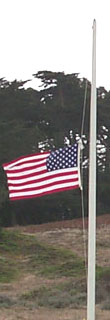 The
flag outside the ranger station at Fort Funston was at half-mast for a week
in June, honoring a park ranger, two volunteers and their pilot who were killed
when their small plane crashed in Alaska's Denali
National Park.
The
flag outside the ranger station at Fort Funston was at half-mast for a week
in June, honoring a park ranger, two volunteers and their pilot who were killed
when their small plane crashed in Alaska's Denali
National Park.
"We had the best rescue crews in the state involved in this search today," said Superintendent Stephen P. Martin. "All of our hearts are aching, these men were members of the community of Talkeetna and the National Park Service. There are no words to describe what an incredible loss this is." Press Release News Report
We may not agree with all of the Park Service's policies, but this is a good time to remember that many good people work hard and sometimes risk their lives in its service. At Fort Funston, we depend on the local rangers to protect and rescue visitors -- both human and canine. Sometimes, the political is not personal. In our battle over Fort Funston policy at the legal and political level, we're using the courts of law and public opinion. But let's maintain and build friendship and respect for the individual Park Service employees on the ground at Fort Funston.
- Michael B. Goldstein, Editor
News, opinions, announcements, documents and images about Fort Funston's future.
COURT REPORT Sunset
Trail GGNRA Meeting Closure
Thoughts Fort
Fenced-In ![]() Land
Grab?
Land
Grab?![]() Editorial
Editorial
![]() Some
Thoughts What
The Judge Ruled Full
Text of Complaint FFDW
Press Release PHOTOS
FROM FENCE! Petition
to GGNRA Submissions
Welcome Cliffs
Photo Links: Bulletin
Board Fort Funston
Dog Walkers S.F.DOG
FreeDog!
Some
Thoughts What
The Judge Ruled Full
Text of Complaint FFDW
Press Release PHOTOS
FROM FENCE! Petition
to GGNRA Submissions
Welcome Cliffs
Photo Links: Bulletin
Board Fort Funston
Dog Walkers S.F.DOG
FreeDog!
JUDGE RULES: OPEN CLOSURE AREAS IN AUGUST!
*****
FULL TEXT OF MAY 16 PRELIMINARY INJUNCTION:
FILED: MAY 16 2000 4:23 PM
IN THE UNITED STATES DISTRICT COURT
FOR THE NORTHERN DISTRICT OF CALIFORNIA
|
No. C 00-00877 WHA |
|
FT. FUNSTON DOG WALKERS, a membership organization; SFDOG, a California limited partnership; LINDA MCKAY, an individual; FLORENCE SARRETT, an individual; LINDSAY KEFAUVER; an individual; and MARION CARDINAL, an individual,
|
Plaintiffs,
V.
|
PRELIMINARY INJUNCTION |
|
BRUCE BABBITT, Secretary of the Interior; ROBERT STANTON, Director of the National Director, Pacific West Region, National Park Service; and BRIAN O'NEILL, General Superintendent of the Golden Gate National Recreation Area,
|
Defendants.
____________________________________/
GOLDEN GATE AUDUBON SOCIETY,
Intervener/Defendant.
____________________________________/
IT IS SO ORDERED.
[ from May 21, 2000 ]
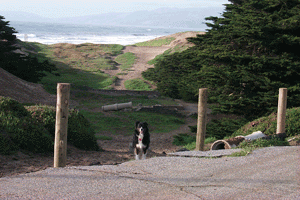 Hi,
I'm Rudy! And, boy, am I excited! The last time I took this walk, as
you can see, fences were being built to keep me out. But come August,
thanks to a preliminary injunction, I'll be able to take this walk again.
Please wait a couple of minutes for the slide show of my walk to begin
playing (unless you're a lucky dog with DSL!) My favorite walk goes
through a historic ruin, a wonderful valley, up over a splendid dune,
down a chute ("The Gap") to the beach, into the water, and
back down the beach. The battle's not over, the fences are going to
remain for the time being, but I'm just thrilled that I will be able
to walk through here again!
Hi,
I'm Rudy! And, boy, am I excited! The last time I took this walk, as
you can see, fences were being built to keep me out. But come August,
thanks to a preliminary injunction, I'll be able to take this walk again.
Please wait a couple of minutes for the slide show of my walk to begin
playing (unless you're a lucky dog with DSL!) My favorite walk goes
through a historic ruin, a wonderful valley, up over a splendid dune,
down a chute ("The Gap") to the beach, into the water, and
back down the beach. The battle's not over, the fences are going to
remain for the time being, but I'm just thrilled that I will be able
to walk through here again!
"Off-Leash" Off Signs!
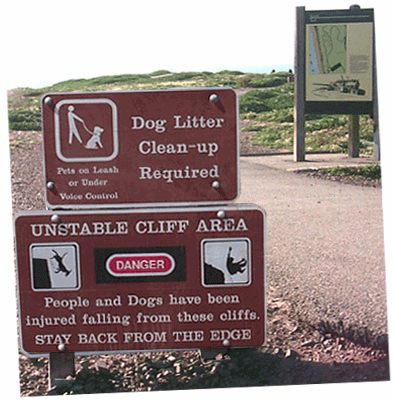

On Thursday, May 11, 2000, the two signs at Fort Funston which advised: "Pets on Leash or Under Voice Control" were gone. One sign, at the parking lot by the bulletin board, had been removed. The other, at the stoplight entrance on Skyline & John Muir Drive, had been carefully painted over in matching brown paint (see photos). Wonder what is the story here... (wait until the slide show begins with the photos changing above!
| UPDATE: Re the change in signs at Fort Funston (all references to off-leash walking have been removed or painted over): we are not aware of any policy change to off-leash walking. Continue to enjoy Fort Funston with your well-behaved, off-leash dog - while you carry bags and a leash. -- - Linda McKay, Fort Funston Dog Walkers |
Here is an example of what a bank swallow colony looks like -- this is the main activity area just south of "The Gap" and far north of the "seasonal closure area." Photo taken on May 3, 2000. There don't appear to be any burrows in the cliffs of the "seasonal closure area," and dozens of photographs documenting their absence were filed as exhibits in the May 4th remedy brief.
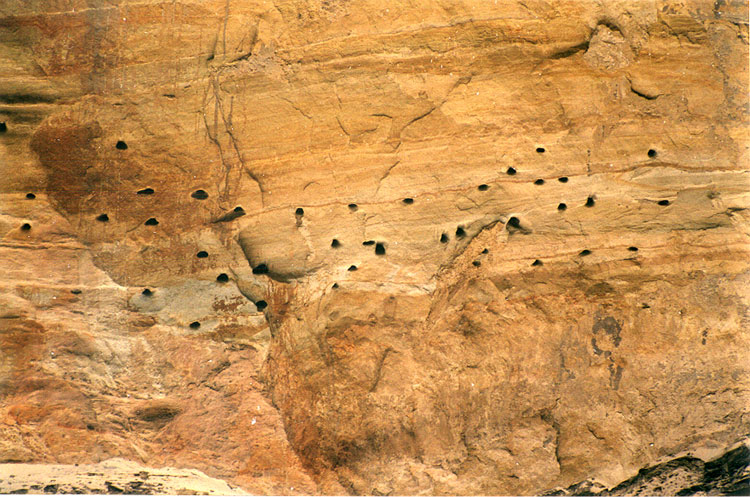
"Open These Gates!", Says Brief
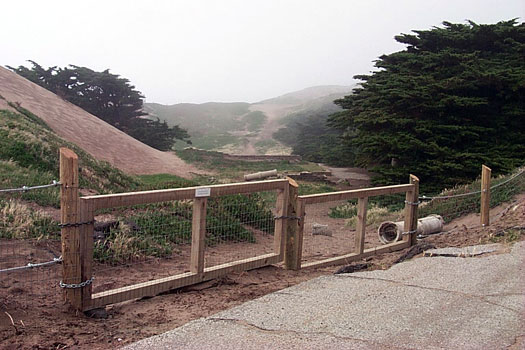
This is one of five access points which the brief filed May 4th asks be opened to permit access to the disputed closure areas.
How to Help Fund the Fort Funston Lawsuit:
As the federal case of Fort Funston Dog Walkers, SF DOG, and four individuals goes forward, we face a long and costly battle to defend our rights at Fort Funston. The National Park Service chose to institute major changes in closing areas of the park, despite their apparent knowledge that this would be "highly controversial" and might cause "significant alteration in the public use pattern." Under these circumstances, regulations require the agency to go through a process known as rulemaking wherein their proposal is published in the Federal Register for scrutiny and comment by the public before a final, published decision is made. That is what the lawsuit is asking if the Park Service intends to leave the current closures in place. In light of the incremental transition the Park Service seems to be making from recreational use to nature preserve at Fort Funston, a full discussion of these changes in a public forum, enlightened by independent science and full input from the current majority of park users -- people who walk their dogs off-leash -- is long overdue.
We've got some hard-won victories already, as the discovery process unearthed a pattern of willful concealment of plans from the dog walkers and the judge opined that the Park Service "railroaded" the closures through without proper process. Our latest win is the judge's May 16 preliminary injunction opening access to the closed areas once the bank swallows leave in August. But this is just the start of a lengthy battle and one that will be extremely expensive even with donations of time and materials from many sources. It's got to be done fully and in a timely manner because each step of the way requires specific work to build on our success so far. We have an excellent legal team and many others contributing skills, but they cannot be expected to work for many months without pay.
The Park Service can count on the U.S. government to defend it, with enormous resources and a legal team at its disposal. Truly, this is a David vs. Goliath fight. It is winnable. It is worth it. There will never be a better time to fight this battle.
In coming weeks, a major campaign will be underway to begin raising the six-figure legal fund needed. Every person who walks a dog at Fort Funston, and others who care about the park or about dogs, will be asked to make a financial contribution to this fight. Many of us have limited incomes and may feel we can't make a contribution. Yet, in light of the importance of Fort Funston as a haven for us and our dear dogs, we really can and must make sacrifices to be a part of this battle to secure our future. Others have the ability to give more, and for you, please put in a more substantial sum at this time. And there are those who are able to give several thousand dollars to the legal fund, and we are counting on many such individuals to come forward now and make that grand contribution. At this time -- that means now -- it is extremely important that we jump-start our fundraising to be absolutely positive that we do everything we can to win this case.
Please get out your checkbook right now, write as large a check as you can possibly stand, and mail it today to one of the two addresses below. And encourage everyone you know to do the same. It's an investment that can yield many more years of joy for you and your dog(s) at Fort Funston!
There are two organizations involved in this fight and contributions may be made to both organizations. If you are a Fort Funston Dog Walkers member, make a contribution to FFDW. On the other hand, if you are an SFDOG member, make a contribution to SFDOG. If you are a member of both, hey! contribute twice! If you are a member of neither, hey! join both! Send a contribution to one or both of legal funds now. Both organizations are parties to the lawsuit and both need to solicit contributions from their members. There is no competition to raise funds. Money contributed to either fund will be used to pay legal expenses for each organization. Our lawyers have expended many more hours on the case than we can possibly pay for, so please, please help! The following are the instructions for making a contribution: . . .
| Check to: | San Francisco Dog Owners Group | Fort Funston Dog Walkers |
| Memo: | Legal fund | Legal fund |
| Address: |
SFDOG PO Box 31071 San Francisco, CA 94131-0071 |
Attn: Linda McKay 241 Tocoloma Ave. San Francisco, CA 94134 |
Bench Bulletin
Before we had news from the Federal bench....
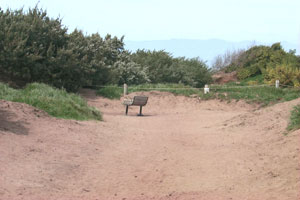
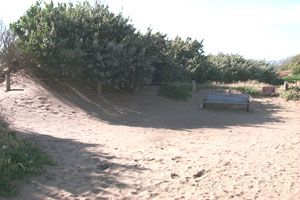
we could only check in on Fort Funston's Musical Bench!
There's something about that corner! That's the one with the rotating signs -- "closed for native plants", then no sign, then "closed for your safety"... at the "L" corner of the Sunset Trail near the Battery Davis tunnel. Now it's the benches that are changing.
A gripe that several people have mentioned concerns the new benches that were finally installed months after the previous benches, trash can and asphalt had been ripped out. It seems the benches are quite tall and uncomfortable.
But the other problem seems to have been fixed. The bench at the corner had for years faced the path, making for friendly conversation and a passing parade of dogs to watch. The new bench was inexplicably placed immediately next to the path -- but with its BACK to the passersby! Seemed like a good idea, surely, since the bench did look out through a gap to the ocean -- a good spot for whale-watching in season.
But people who need people -- and dogs -- preferred to sit facing the passersby. Miraculously, this request appears to have been granted, even if the bench is still not as comfy as the previous one.

Earth Day Editorial: Where's the Science? by Michael B. Goldstein
Ecology: The science of the relationships between organisms and their environments.
[The American Heritage® Dictionary of the English Language, Third Edition]Protecting the environment depends on good science. Good intentions aren't enough. "Common sense" ideas about cause and effect are often not true. The Law of Unintended Consequences means that the best laid plans often end up backfiring. And these mistakes can have a ripple effect, throwing an entire ecosystem out of balance.
That is why it is troubling to see how the National Park Service has approached the ecology of Fort Funston. In the current bank swallow debate, many dog owners and others would have been willing to accept major restrictions on land use if valid scientific studies had been presented for review in a public forum. But we had neither studies nor forum.
Instead, and mostly through a federal lawsuit, we found a history of changing rationales for one land closure after another.
The '95 northern closure was for the bank swallow habitat. But the swallows don't go there anymore. If you go there, you'll see these signs, just thirty feet apart (photo: April 17th.) One cites the bank swallow habitat; the other, native plant restoration.
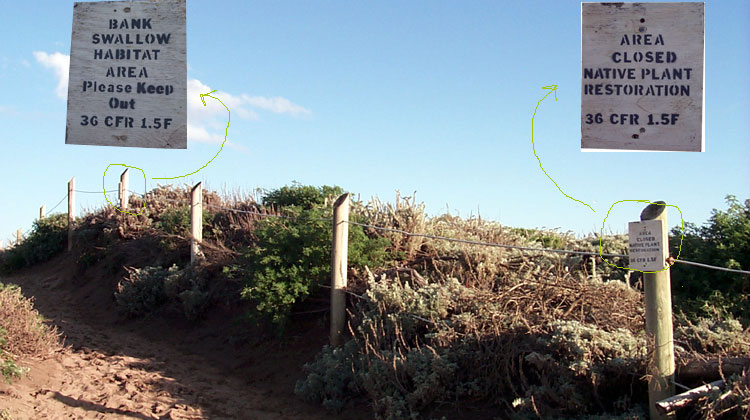
The two are related, of course; everything's related in the environment. One claim has been that, by keeping people and dogs out of the new, "permanent" closure area, ripping out the existing ice plant and planting so-called native plants, this will help the bank swallows. It's reasoned that, even though the bank swallows feed on insects primarily at Lake Merced, introducing new native plants would increase biodiversity, thereby increasing the insect count and helping provide supplemental food for the bank swallows.
A wide swath of land, many acres more than simply the cliffs, has been completely closed to recreational use half the year (the "seasonal" closure area) in the name of bank swallow habitat protection but with virtually no scientific justification.
Then there was the other '95 closure, the hillside between Battery Davis and the beach access route near the base of the "loop". This closure was also done in the name of native plant restoration, and was then to be reopened in five years. However, whatever the rationale for the planting, it never happened and that land has recently had its signs changed to read, "Closed for Your Safety," with no further details.
Finally, the Sunset Trail was abruptly closed for months and only reopened partially (still closed to those who can't traverse its now unpaved and uneven sandy surfaces) after a firestorm of protest. No scientific studies were put forth by the Park Service, which claimed later that much of the route was unsafe pavement, not documented, to justify what appeared to many to be an outright falsehood. An April 5th letter to the GGNRA from the chair of the Conservation Committee of the Golden Gate Audubon Society recommends closure of that zone as well, claiming that erosion from usage is a threat to the adjacent cliffs. Again, little in the way of verifiable evidence to back up such claims.
Combined, these five zones represent the vast majority of the coastal bluffs of Fort Funston. How would the environment, which includes humans and dogs, be impacted by such a severe closure? Where are the assumptions, hypotheses, predictions, criteria, controlled experiments, data from observation, results, interpretations, and repeatability that would be the foundation of valid scientific studies of Fort Funston's ecology?
Fort Funston is not an island; it's part of a system. That system, the National Park Service, is run by administrators who, according to an article in Science magazine this month [ 1. ] ,
"have tended to view science with anything from benign neglect to outright hostility. The result has been a number of decisions that have been slammed by scientists, challenged in court, and even debated in Congress..."
Later, the article states,
"A 1992 study by the National Academy of Sciences, for instance, found that 'almost invariably... management of the parks was done with inadequate understanding of ecological systems.' And the science that has been done has often been manipulated to support policy, critics allege. Park managers 'have very carefully controlled the actual research that's done and the reporting of that research,' says ecologist Fred Wagner of Utah State University in Logan, citing studies of elk and grizzly bears in Yellowstone National Park.".
"Critics also question the extent of support for the science program among top Park Service leaders. 'Part of the challenge is to change the culture of the Park Service,' concedes [Gary Machlis, an outside scientist helping steer the science plan at the NPS.] Each park is a fiefdom ruled by its superintendent, and superintendents vary in their interest in science, [NPS historian Richard] Sellars points out. Indeed, only one superintendent from the largest parks rose from the ranks of resource managers rather than park rangers. [The leader of the new science program, Michael] Soukup wants to address that by promoting resource managers and grading superintendents on how well they use science. After all, the best scientific advice in the world won't help if no one at the top is listening."
[ 1. ] "Bringing Science to the National Parks" by Jocelyn Kaiser, SCIENCE, 7 April 2000, p. 34.
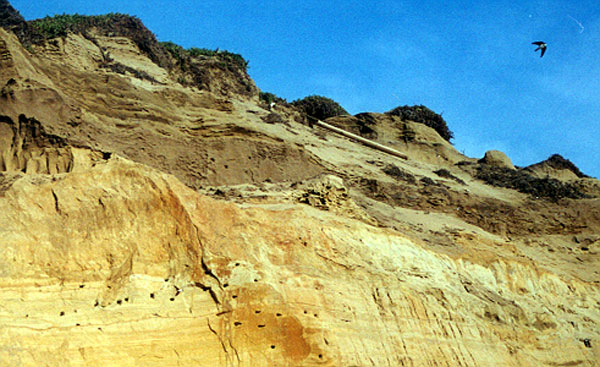
What appears to be a hawk hovers near the bank swallow habitat on April 20th. Hawks and other predators swoop down and devour hatchlings waiting at the entrance to their burrows for their parents to return with food. This is a part of nature's course, but since the bank swallows are a threatened species (although not an endangered species as stated on Park Service signs put up with the seasonal closure on April 12th) efforts may be made to discourage this activity. It's possible that human and dog activity in the now closed area would reduce the birds of prey's numbers and thereby help protect the bank swallow habitat. Research (2) found adjacent land use common and not generally harmful to bank swallow colonies. The post just below the top of the cliffs is one of dozens of damaged or destroyed fenceposts and signs, previous years' attempts to protect the bank swallows, which the Park Service has neglected to maintain while going forward with a much more costly and controversial closure plan this year.
Comments on this Earthday Editorial? Please click here to send an e-mail message!
Fort Funston Forum is an independent publication. The opinions expressed are those of the editor and identified writers, and are specifically not presented here as the opinions of any other person or organization involved with current issues at Fort Funston. ***** Michael B. Goldstein, Editor
When does the past begin? The creation, flood, the exodus, last year?

by R. Gene Geisler April 15, 2000 Comment on:
The government attorney claimed that "The resources at Fort Funston right now are not in as good shape as they should be" and went on to suggest that the park should be restored to be "as it was" in the past.
What is meant by the "past". I saw that land during the Korean War (1950-54) when the Western Army Antiaircraft Command had an anti-aircraft battery there. I was aide-de-camp to the CG of WAAC and we visited the site because of the problem of blowing sand and the sand dust sensitive computer, radar and and antiaircraft guns which were there. The area was moving dunes and the WAAC worked to strengthen the ice plant which was already there and stabilized the dunes insofar as they were stable. I was not aware of native plants in any profusion such as exists in the north enclosed area after much prolonged effort by the Park Service and their Native Plant fanatics. If the area had had a cover such as that, it would have been a fire hazard what with an entire battery of men living there.
I could argue that the removal of the ice plant and the moisture it retains all year sustaining a healthy soil is what has injured the nesting habits of the birds. For all we know, the decline of their population was stimulated by DDT in Mexico, or the place where they spend the winters or summers rather than the place where they merely breed. If the bird colony has been there since 1927 then it had adapted to living with the ice plant. The introduction of species arbitrarily designated as native (who defines "native"?) coincides with the confusion of the birds as to their nesting sites.
You might also argue that it was the ice plant which encouraged the species there in the first place. This I do argue is a case of the Law of unintended consequences. The do gooders destroy the habitat in the name of some higher good: native plants. By removing the existing cover they destroy the habitat to which the birds had adapted.
Fort Funston, in the 20th and probably in the 19th century has been just that: a military Fort with all the concerns that a military post has for livability, utility, etc. First it was the coast artillery; then it was the antiaircraft artillery. The ice plant was a very practical solution to a serious problem: moving dunes and blowing sand. Just as the eucalyptus tree was a very practical way to obtain shade along el camino real which so often traversed chaparral. I am prepared to argue that they are both natives today: Not the plants which were never really there and which in any case did not prevent the dunes from moving the way the ice plant did and does yet when left alone. I have a feeling that FF became a recreation area after the aircraft carrier and long range bombers made it obsolete. The military needed to justify holding onto coastal property "just in case it is ever needed".
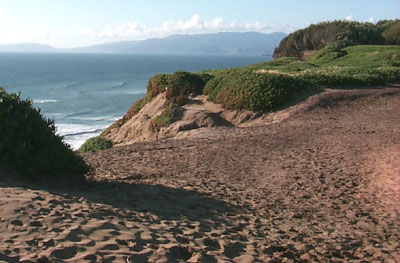 My
Heart Is Broken by
J. Davis April 15, 2000
My
Heart Is Broken by
J. Davis April 15, 2000
I was not able to be at the 14 April court hearing because I was having a facet nerve block at that exact time (needles injecting fluid into my spine), although I was with all of you in spirit. I am terribly upset about the closure of the Sunset Trail and I want to do everything I can to help the Fort Funston Dog Walkers fight this issue.
My story: I moved to this area in the Fall of 1998 and immediately fell in love with Fort Funston. I feel a special calling to that place; it's one of my favorite spots on this planet. My husband and I are allergic to dogs, but we love getting out and watching all the dogs bounding over the hills filled with joy at their freedom. The views of the Pacific and the sky are stunning, and the park is quiet and safe.
Fort Funston took on a new meaning for me in September of 1999 when I herniated a disk and became disabled. Because I cannot sit without incapacitating pain, I am unable to work. As part of my physical therapy, when I could still walk, I was walking almost daily on the Sunset Trail, which was level (I cannot walk up slopes) and paved (I cannot walk in uneven sand) and had the kind of scenery that would drag me out of my depression and pain and get me to exercise. Then I became too injured to even do that, and I did not make it to Fort Funston for months. But I always counted on the Sunset Trail to be there when I was able to learn to walk again. I was deeply dismayed to find out that it has been closed. I went up a week or so ago to view the convergence of Jupiter, Saturn, and Mars with the moon, and walked out on the trail to see for myself where the pavement ended and where mere sand--opened at that time to dog walkers--remained. It sickened me.
I believe that this may be a valid Americans with Disabilities Act issue, because my access to the park is now nearly void. (Most other trails involve hills and stairs, I believe; that was the only level, paved section.) Even though I am not in a wheelchair, I am unable to walk my beloved park now. A wheelchair-bound person is more visually obviously but similarly screwed in terms of access now.
This is all somewhat ironic for me because I am a beginning birder myself. I want the needs of dogs, humans, and swallows and other birds to be balanced. But I do not feel that all of these needs were taken into consideration in the behind-closed-doors process used by the Park Service. I agree with the Fort Funston Dog Walkers that this issue needs to be decided in the public domain with more studies.
Thank you for keeping the web site up-to-date; it was a relief to be able to log on today, one day after the hearing, and to read such a thorough description of what happened. I learned about this whole issue from your website in the first place, since I hadn't been to Fort Funston since January (when I went with my parents right before my first injection procedure, hobbling out just to the deck). Anyway, your website probably has impact that you never imagined, and thanks again for the obvious hard work that's gone into it.
I will be sending my donation check to the legal fund today and would be happy to help out as much as I can given my limited mobility. Thank you for taking up the cause and organizing so well. It isn't just the dog walkers who are affected, although I am still amazed by the strength and persistence of how you have all organized to save the park for all of us.
Bluff Failures on the Sunset Trail - {from March 31st issue}
They're back!

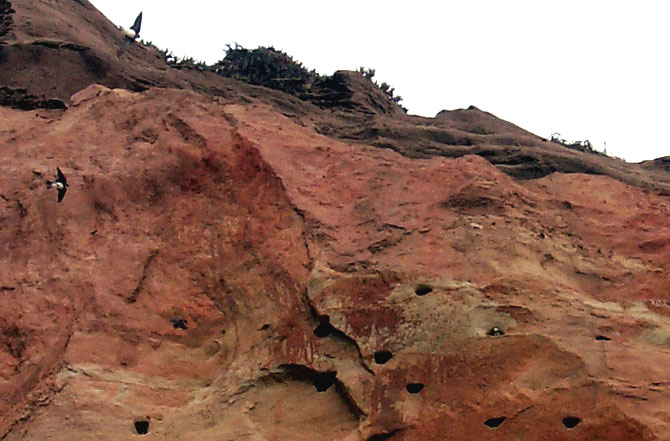
Share your sightings -- when, where, how many... new feature:
Fort Funston Forum'sBirders' NotebookDon't worry, everyone's a birder here! You don't need an impressive Life List, just an interest in the birds of Fort Funston. Since it's bank swallow (Riparia riparia) season, we'll start out with these fascinating birds.This is an interactive section! Please e-mail your sightings, comments, and questions to this brand-new section of Fort Funston Forum.If you love dogs, you know how endlessly fascinating it is to watch other species in action! There are so many behaviors that have evolved to perfectly suit each creature. Let's enjoy the presence of the bank swallow population at Fort Funston, as we learn more about their habits.The swallows have just arrived from South America for their annual nesting season over the next few months here in the steep cliffs of Fort Funston. They'll be laying eggs at the back of their yard-long burrows in the cliffs, and feeding on insects primarily above Lake Merced.Although not too common along the California coast, bank swallows are much more plentiful along inland rivers such as the Sacramento, and even more are to be found in other states and countries.Thanks for stopping by the Birders' Notebook. Please say hello to kick off the notebook with some introductions. Thanks.- Michael B. Goldstein, Editor, Fort Funston Forum |
|
To PRINT or view just the court report below,
without the rest of the page click here
|
"The Court's not going to rule right now," U.S. District Court Judge William H. Alsup declared to a packed courtroom at the conclusion of the Friday, April 14th injunction hearing. The motion is under submission while the judge takes time to think about the issues raised. Then he expects to issue a written order, probably within the next week. The judge remarked to the audience that the dog walkers should be very proud of their lawyers, whom he commended for their excellent work and commitment to the public interest.
Tossing aside a pile of interrelated issues, the judge repeatedly returned to the point that, "The only question is whether [the National Park Service] should have held a public hearing." Was there a point in time, he asked, when they asked themselves, "Is this highly controversial?" The government did not present evidence that the Park Service had made any determination as to whether their intended closures would likely be highly controversial or might result in significant alteration in public land use patterns. Yet the trail of evidence from discovery shows that they did indeed expect controversy and planned ways to avoid input from dog owners who might disagree with their plans. To the extent that they did prepare a memorandum of their plans, it was filed a few days after, and perhaps as a result of, the dog walkers' lawsuit threat. (On February 25th, the dog walkers let the Park Service know that they were considering filing for a Temporary Restraining Order. One week later on March 3rd the Park Service issued their memorandum justifying the closures which were already in progress. The judge questioned whether this could "suggest this was done in anticipation of litigation, to fix the record up.")
"It sort of sounds like the Park Service is afraid to let the public have input," remarked the judge, after saying that, "There was some evidence that would support the proposition that the officials in the Park Service recognized that the dog walkers would not be happy with the decision and wanted to run it through as quickly as possible."
"It sounds like as soon as the D-day boats are launched, they want them on the cliffs immediately so there won't be any time for opposition," continued the judge. A number of times in the dog walkers' brief the Park Service's own e-mail suggests a deliberate plan to implement the fence-building very quickly, with a public relations person on site to deal with any problems.
If the judge does decide that there has been a violation of the law in that the Park Service did not go through the proper public rulemaking and comment process mandated for a "highly controversial" change, or a major change in the use pattern of the park, he noted that he would likely have a separate hearing to see if there was a remedy for that.
It could be that the result would be that the Park Service would have to go through the legally-mandated process of publication in the Federal Register, a sixty-day comment period, and then issue a decision. The decision might be the same one, but at least the law would have been followed and park users would have the chance to organize and speak out on the issue.
A partial temporary restraining order has been in effect since the initial March 14th hearing. This order permitted the Park Service to go ahead with the permanent closure area, but not to seal access to the seasonal closure area. The only way that could be done, the judge said at the previous hearing, would be for the Park Service to declare an emergency upon the return of the bank swallows. In the case of a so-called "emergency", the Park Service has wide discretion to close areas with no notice or input. That's precisely what happened two days prior to the hearing, when the Park Service declared an emergency and closed the seasonal area.
Another issue that has bothered the dog walkers is the fact that the previous bank swallow closure, at the very north end of Fort Funston, remains closed even though the reason for the new closures is said to be that the birds have moved their burrows south, and no longer nest in the originally closed zone. "So, if they're no longer in the north end, why don't you open that up?" the judge inquired. The very steep cliffs which the bank swallows apparently require are no longer in existence in the previous closure area, due to El Niño storm erosion. The defense claimed that the area still must be left available for the bank swallows, just in case they decide to nest there in the future. (The Audubon Society has also recommended that the Sunset Trail area be permanently closed so as to protect the cliffs below, although there has been no evidence presented of bank swallows active in that area, either.)
The government attorney claimed that "The resources at Fort Funston right now are not in as good shape as they should be" and went on to suggest that the park should be restored to be "as it was" in the past. This is similar to charges made at the Advisory Commission meeting comment period on March 21st; both charges are presented with no specific evidence to back them up. A decision to change Fort Funston's habitat is a major one for which the Park Service acknowledges it has no written plan.
The Audubon Society (which joined the case on the government's side early on) argued through its attorney that Federal rulemaking was not required in this case, which is the main claim of the Park Service. The judge challenged the Audubon attorney on this point. If the situation were reversed, he said, if the government said "forget it, take down the fences", and did not take any action supposedly on behalf of the bank swallows, wouldn't the Audubon Society be in court arguing the opposite position -- that rulemaking was required?
There were smaller instances of haggling over technicalities, representative of an ongoing habit of the Park Service in and out of court to come up with somewhat suspect explanations for unfavorable facts. Two examples: It's a matter of record that the Park Service originally presented this newest closure acreage to the public -- and even to the Court -- as approximately six acres, only to later correct that to over nine acres. This was explained in court as resulting from technical changes in the GPS equipment accuracy having improved in the intervening period to better measure changes in topography. In the other case, a map was presented in court which had been handed out at Fort Funston by a staff person. However, the defense challenged the map and a ranger declared that it was only a draft which had been created by a student working with a previous employee, and was never finalized for public use. (The map showed beach access at the area now in the permanent closure, known as "The Gap." At issue was whether that passage was ever officially considered a beach access route. The judge then refused to consider the map or the issue it raised, that one of three beach access routes had been blocked.)
The Park Service also claimed in its newest closure signs (see photo below) that the bank swallows are an "endangered species." This is patently false; they are categorized as "California threatened", and even in California are plentiful in the inland river areas such as along the Sacramento River. They are more commonly found in states outside California. The judge was advised of the illegitimate "endangered" claim, but said that this wasn't relevant as the Park Service could do whatever it wanted under an emergency ruling -- it wouldn't even have to find them threatened.
One undocumented claim was a purported survey of park users in support of the project, presented by the Assistant United States Attorney. However, upon questioning from the judge, the attorney could not provide details on this survey, which was not included in the court record, and could not even say what the wording of the question had been.
The crucial factor in the current situation is the decision of the Park Service just two days before the hearing to declare a state of emergency, allowing for closure without hearing or comment.
"The Park Service has made a complete end-run around this lawsuit by declaring this emergency" the judge noted. Was there indeed a genuine emergency requiring closure of the entire area to protect the bank swallows? An "arbitrary and capricious" closure could be challenged via an amendment to the original complaint, despite the wide berth the Park Service enjoys for managing its land as it sees fit. Although the dog walkers have made it clear that they support protection of the bank swallows nesting habitat along the cliffs, and might accept a fence along the edge of the cliffs, they reject strongly the notion that a closure area of nearly ten acres that extends way back from the coast is necessary.
The judge seemed most intent on determining what might happen in August, after the bank swallows leave on their southern migration -- then would the area be opened again, would the emergency be lifted? He suggested, but did not order, that the government begin looking into going through the required rulemaking process for publication in the Federal Register and an opportunity for comment over a 60-day period.
As soon as more details are available, or a court order is released, the information will be available on this website. Meanwhile, if you have comments for publication, please send them in via e-mail.
Following is the April 12 letter to Judge Alsup from the government, as well as the memorandum of the same day from the Park Service which declares an emergency over the return, as every year since at least 1927, of the bank swallows to Fort Funston. The two referenced supporting documents are ten pages long and may be published on this site in the future.
United States Attorney
Northern District of California
10th Floor, Federal Building, Box 36055
450 Golden Gate Avenue
San Francisco, California 94102
(415) 436-7180
FAX: (415) 436-6748
April 12, 2000
VIA MESSENGER
The Honorable William H. Alsup
United States District Court
450 Golden Gate Avenue, 19th Floor
San Francisco, CA 94102
Re: Ft. Funston Dog Walkers, et al. v. Bruce Babbitt, et al.
C 00 0877 WHA
Dear Judge Alsup:
This is to advise you that Park Service personnel confirmed sightings of bank swallows in the vicinity of the seasonal closure area at Ft. Funston yesterday afternoon, shortly after the Court and parties left the park.
Based on consultation with the California Department of Fish and Game and the Audubon Society, and on the NPS guidance requiring protection of special status species and the determination in the March 3, 2000 memorandum, the Park Service has determined that an emergency situation exists that requires closure of the seasonal closure area at Ft. Funston in order to protect the habitat of the state threatened bank swallow. The emergency closure is authorized by Section 1.5 of 36 C.F.R. A Park Service memorandum documenting this action, Subject: Emergency Closure of Bank Swallow Habitat - Fort Funston, is enclosed.
Inasmuch as the basis for the Park Service's closure of the area (i.e., now an emergency) has changed from that which was the case when the Plaintiffs originally filed their Complaint, it appears that the issues raised by the Complaint are now moot.
Thank you.
Very truly yours,
ROBERT S. MUELLER, III
United States Attorney
CHARLES M. O'CONNOR
Assistant United States Attorney
CMO: sc
Enclosure
cc: (via facsimile)
Lydia Owen Boesch, Esq.
John Keating, Esq.
Kelly L. Drumm, Esq.
Nicole J. Walthall, Esq.
United States Department of the Interior
NATIONAL PARK SERVICE
Golden Gate National Recreation Area
Fort Mason, San Francisco, California 94123
N1621 (GOGA-SUPT)
April 12, 2000
Memorandum
To: Files
Through: General Superintendent, Golden Gate NRA
From: Assistant Superintendent, Operations, Golden Gate NRA
Subject: Emergency Closure of Bank Swallow Habitat - Fort Funston
This memorandum documents the emergency closure of bank swallow habitat at Fort Funston which was implemented on April 12, 2000 at approximately 9:00 a.m. Section 1.5 of 36 C.F.R., Closures and Public Use Limits, permits closures in emergency situations without completing the formal documentation and public notice requirements of Sections 1.5 and 1.7. The emergency closure of the seasonal-closure area is necessary for the protection of natural resources, specifically bank swallow habitat at Fort Funston, one of only two remaining coastal cliff-dwelling colonies in California.
In anticipation of the return of the bank swallow to the bluffs at Fort Funston, the park began non-emergency closure procedures in accordance with 36 C.F.R. Section 1.5. A March 3, 200 memorandum to the files was prepared that justified the determination that the permanent and seasonal closure areas for purposes of natural resource protection, native habitat restoration and public safety, and documented the public notice provided for such closure. Fencing of the permanent closure area was completed on March 20, 2000. Fencing of the seasonal area was completed on March 17, 2000, with access gates to remain open until the bank swallows returned to nest at Fort Funston.
On March 13, 2000, before the swallows returned, the Fort Funston dog walkers and other affiliated groups filed for a temporary restraining order in Federal Court, seeking to prevent further fencing work at the site and to allow the area to remain open for recreational activities. On Tuesday, March 14th, the Dog Walkers' request was partially granted on a temporary basis, whereby the gates accessing the seasonal closure area were ordered to stay open, but fencing of the permanent closure area could continue and, when completed, could remain closed. The court order set a hearing on the issue of the closures for April 14, 2000, and permitted the National Park Service to close the seasonal area if an emergency situation arose before the April 14th hearing.
Bank swallows have been nesting at Fort Funston since at least 1927 and typically arrive in late March or early April. On April 11, 2000, bank swallows were observed in the vicinity of the seasonal closure area. In consulting with the California Department of Fish & Game and the Audubon Society (attached hereto), and based upon the NPS guidance requiring protection of special status species (NPS Management Policies, Chapter 4, and NPS-77) and the determination contained in the March 3, 2000 memorandum, the park has determined that an emergency situation exists that requires closure of the seasonal closure area at Fort Funston in order to protect the habitat of the state threatened bank swallow. Accordingly, the seasonal area was gated and closed to public access on April 12, 2000, at approximately 9:00 a.m.
Based on the above, this memorandum serves as a determination that emergency closure of the subject area is necessary for the protection of natural resources, and no less restrictive measures would suffice.
[Signed, Terri Thomas, for]
Mary G. Scott
Assistant Superintendent
Attachments (2):
Declaration by Ronald Schlorff of April 3, 2000
Letter from Audubon Society of April 5, 2000
[ from Thursday, April 13, 2000 ]
Gate Accompli
Remarkable timing: we're told that the bank swallows are back! Wednesday, April 12, 2000 -- just two days before the injunction hearing -- locked gates appeared and the seasonal closure went into effect.
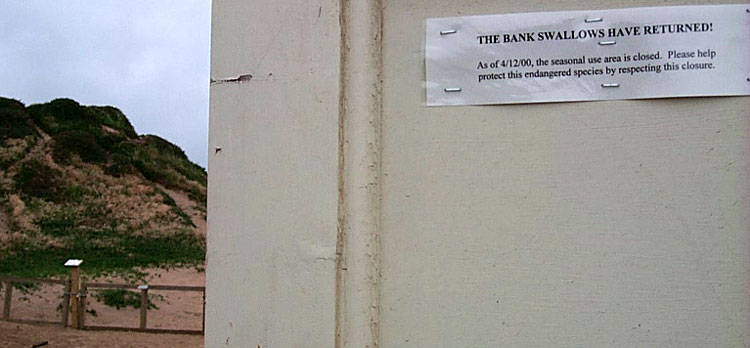
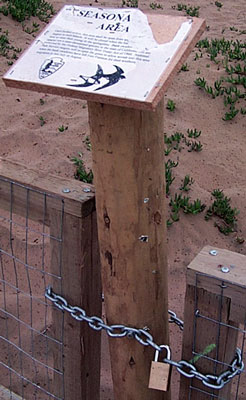
Note the remaining scraps of dog photos from March 4th protest!
CLICK HERE to see those photos.
CLICK HERE for Yahoo map of Civic Center / Federal Building at 450 Golden Gate Avenue (between Polk & Larkin)
Help Make History!
For so long, all we could do was complain to each other about one problem after another at Fort Funston. And we were good at that! But then all of a sudden the Sunset Trail was simply closed with no warning or explanation. When that was followed shortly by the deployment of closures and ugly fences over ancient sand dunes, in the name of nature but without a basis in natural science, we finally said, "Enough!" We haven't stopped since. Where the Park Service expected a brief brouhaha to be smoothed over with an onsite flak, instead we filed a federal lawsuit and discovered the truth -- and it was worse than we'd imagined. We'd been kept in the dark while a major change in the park's use was put into motion -- the park where we make up the overwhelming majority of users.
It's hard to see in the rush of events (we're all operating in accelerated dog years lately!) but this is history in the making. We have the opportunity to establish a clear judicial precedent in the course of this trial, which could affect federal court decisions for years to come. And the outcome may well affect off-leash opportunities for many years.
This is literally "a federal case" -- it's serious, folks! It's not some frivolous lawsuit just because we're mad.
See where it began with the original complaint, review the astounding facts discovered and documented in the brief (or the briefer summary in the booklet), check out the hard-hitting reply brief and think about what it took to prepare all the meticulously studied and referenced source documents. We've got a team of attorneys and others, all putting in superhuman effort to make sure we are heard.
But we need money to do that, and we need it now. In this moment, as we all hold our breaths and await the next step in the case, we need to pull out our checkbooks and contribute to the legal fund. Make as large a contribution as you possibly can -- there have been contributions in the thousands of dollars from individuals, and much smaller ones which add up to thousands. Write the check and put it in today's mail!
There are two organizations involved in this fight and contributions may be made to both organizations. If you are a Fort Funston Dog Walkers member, make a contribution to FFDW. On the other hand, if you are an SFDOG member, make a contribution to SFDOG. If you are a member of both, hey! contribute twice! If you are a member of neither, hey! join both! Send a contribution to one or both of legal funds now. The following are the instructions for making a contribution: . . .
| Check to: | San Francisco Dog Owners Group | Fort Funston Dog Walkers |
| Memo: | Legal fund | Legal fund |
| Address: |
SFDOG PO Box 31071 San Francisco, CA 94131-0071 |
Attn: Linda McKay 241 Tocoloma Ave. San Francisco, CA 94134 |
"Some individuals in the Park Service wish ultimately to substantially restrict the traditional recreational uses of the park in favor of fenced-off areas for use by those who wish to create new Anative@ plant populations or wildlife habitat. That long-term agenda to change the general park use should be considered carefully rather than pushed through quickly under the false pretext of protecting bank swallows. That is particularly so where the Park Service suggests it needs to do a dramatic act without clear indication the changes will help the bank swallows, while for years the Park Service fails to do other minimal acts that have been recommended as clearly beneficial to protect the swallows.
Monday, attorneys for the Fort Funston Dog Walkers, SF DOG, and the individual plaintiffs in the case against the National Park Service filed their reply brief. The first part of the introduction to the reply brief appears below, followed by a link to the entire document. Take the time to look over the brief and reply brief, and come to court on Friday at 8:00 am in Courtroom 9, 19th floor, Federal Building, 450 Golden Gate Avenue, San Francisco.
|
INTRODUCTION The
Park Service closed much more of Fort Funston than is reasonably
necessary for the bank swallow protection benefit the Park Service
claims to seek. The Park Service unnecessarily has fenced the
public out of the prime off-trail recreational area of the park,
without adequate analysis of or due care for the consequences
to public recreation, the threatened bird, or the ecology.
An injunction is appropriate to stop these arbitrary actions
and potential damage in the interim, to allow adequate analysis
and public input on the changes. The
bank swallows have not yet returned.
It is not known where they will nest if they do return. Nor is it clear that the bank swallows will benefit from the closure
of the cliffs and land beyond.
Just in case there might be such benefit, plaintiffs suggest
that a less damaging alternative, such as a temporary fence or
signs placed twenty to forty feet back from the cliffs, will satisfy
any interest in protecting the bank swallows.
A fence back from the cliffs also would serve the suggested
interest of reducing the danger of individuals falling off or
climbing down the bluffs. The
Park Service fails to provide a substantial basis for an urgent
need to close the additional large recreational area inland from
the bluffs. The
other claimed basis for the closure of the additional recreational
area -- to create a new Anative@ plant or wildlife habitat area -- is a long-term agenda of the Park Service,
rather than an interest warranting implementation on an urgent
basis prior to ordinary analysis and public input.
As there is no evidence of an urgent need for closure of
the additional recreational area, nor even clear evidence that
the closure will eventually assist rather than harm the threatened
birds, the immediate harm to the public and the risk of potential
harm to the threatened bird colony far outweigh the speculative
long-term benefit hoped for by the Park Service. Defendants= brief curiously devalues the importance of
public access to this particular park area.
Although they now pretend that they believe the closure
is not highly controversial or a significant change in the public
use, their current posture is belied by their prior unusual strategic
conduct to avoid the very public controversy they deny exists.
The Park Service delayed and kept the plans secret until
announcing and implementing them quickly at the most opportune
time, arranged special payment terms to encourage the construction
workers to get Ain and out as quickly and professionally as possible@ because Athe project is that political,@ and went to the extreme of hiring a special public relations employee
for the project so as to have a spokesperson at the construction
site for the duration of the project.
Park
Service employees had for a long period developed the plan with
individuals from outside advocacy groups friendly to the plan,
but hid the secret intentions from the much more numerous primary
users of the park. After keeping the plans secret for almost a
year, the Park Service then announced and implemented the stealth
closure with specially orchestrated speed to avoid public controversy. It did so at the last hour before the expected
return of the bank swallows, thereby having advantage of the pretext
urgency of the closure. In
such circumstances, it is particularly appropriate to require
the Park Service to abide by the public input and impact analysis
requirements the Park Service is trying to sidestep. Defendants= real motivation in trying to ramrod through the closure of the additional
recreational area is plainly evident from their conduct and internal
memoranda. Some individuals
in the Park Service wish ultimately to substantially restrict
the traditional recreational uses of the park in favor of fenced-off
areas for use by those who wish to create new Anative@ plant populations or wildlife habitat. That long-term agenda to change the general park use should be considered
carefully rather than pushed through quickly under the false pretext
of protecting bank swallows.
That is particularly so where the Park Service suggests
it needs to do a dramatic act without clear indication the changes
will help the bank swallows, while for years the Park Service
fails to do other minimal acts that have been recommended as clearly
beneficial to protect the swallows. In addition, although the Park Service indicates it will not even get around to planting in some of the area for five to ten years, and although there are many other areas of Fort Funston which would be appropriate Anative@ plant restoration zones and would not be controversial, the Park Service chose to close off the most highly used off-trail recreational area of the park............ CLICK
HERE
for entire reply brief
|
"We believe we fairly set forth the facts in the brief. We believe there is a lot of controversy as to what is best for the bank swallows, and that the controversy needs to be aired out in order to reach the best solution for the bird . We also think that the facts establish that GGNRA was not forthcoming with lots of people, including the Court." - Lydia Owen Boesch, Attorney for Fort Funston Dog Walkers et al. 4/3/00
CLICK HERE for text of booklet with highlights from brief
CLICK HERE for brief filed April 3rd
Rotating Closure Signs & Reasons

Please wait for this sequence of three photos to load. Unless you have a very fast connection, it may take a few minutes, but it's interesting so don't give up; wait for the slide show!

Here is a typical example of the trouble with the Fort Funston closures. This lovely large parcel of land, including also a chunk above and to the left behind the trees, was closed in 1995, without public input, for the express purpose of native plant restoration. Native plant restoration was NOT done and the site continued to be shut off from public use. Now that this has been brought to light through the lawsuit and publicity, just in the past month the native plant signs have been removed, and a few days later replaced by signs claiming a safety need. This is evidenced in the photo sequence on top, all photos taken at the "L" corner on the Sunset Trail near the new bench that faces out to sea.
You can see from the photo above that most of this land is set way back from the cliffs, so what is the safety issue here? It's hard to not make fun of a process that is so transparent, but at the same time it is deeply maddening that so much public land has been shut off for reasons that clearly aren't valid.
Rudy's Walk

Hi, I'm Rudy! Please wait a couple of minutes, then come with me for a walk I used to take. It goes through a historic ruin, a wonderful valley, up over a splendid dune, down a chute to the beach, into the water, and back down the beach. Now proposed to be off-limits, AND the viewscape ruined by new fences. Why?
Bluff Failures on The Sunset Trail
"In order to carry out our mission, we must ensure that park sites are physically accessible to all. We take our mission seriously and strive to ensure that those with disabilities can enjoy the resources that make this park special..." ........ "We approach accessibility in many different ways, and welcome input from visitors and experts in the field as well as from our park staff." ........ "The EOC [Equal Opportunity Committee] mission statement includes the park serving as a National Park Service model when complying with the Americans with Disabilities Act (ADA), and ensuring that accessibility standards are met or surpassed parkwide at all facilities and in all programs." - G.G.N.R.A. General Superintendent Brian O'Neill
all of above in: Park News, Fall '99 G.G.N.R.A. magazine: www.nps.gov/fopo/parknews/fall99/parknews.htm
"Accessibility: Fort Mason Center: with advance notice, arrangements can be made for people with mobility impairments and wheelchair users, (415) 441-5706. Fort Point and The bookstore: video screening room and rest rooms are accessible. Muir Woods National Monument: all paved trails are handicapped accessible. Alcatraz: rest rooms at the dock and at the top of the hill are accessible, as is the main level of the cellhouse. The Blue & Gold Fleet, the ferry ride is accessible. SEAT (Sustainable Easy Access Transport) vehicle is available on Alcatraz for accessible transport to the cellhouse. Presidio: visitor center, main post walk and Golden Gate Promenade are accessible. Crissy Field: portions are accessible. Fort Funston: wheelchair accessible, loop trail. Cliff House: limited accessibility."
- from main page of G.G.N.R.A. website at: www.nps.gov/goga (bold added)
Oh....., Wheely?
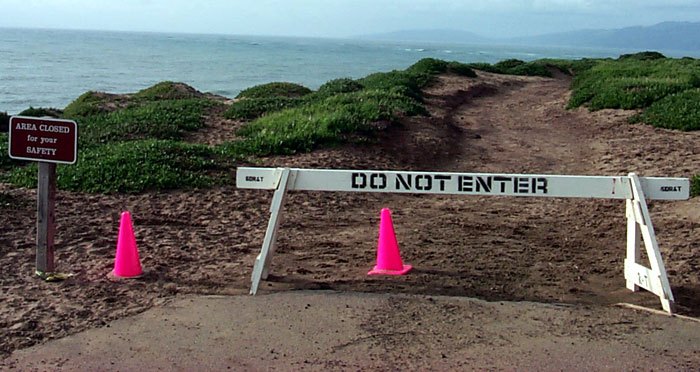
The Sunset Trail is an important and very popular section of Fort Funston. For many people visiting the Fort for the first time, it's their Main Street. It heads right out from the parking lot, towards a beautiful view of the coast and the Marin headlands. It's long been used by dog walkers, tourists, whale-watchers, folks interested in its historic gun-batteries -- and especially by people with wheelchairs and strollers, because it's a paved trail. Or, rather, it was paved. Then out of the blue one day early this year, the Sunset Trail was closed, apparently for good, if not for good reason.

In the "Declaration of Mary Gibson Scott in Opposition to Temporary Restraining Order" starting at paragraph 12 on page 3 and continuing through the verification paragraph and signature the declaration reads: "12. A portion of the Sunset Trail was closed due to failing and eroding pavement on an emergency basis. It was reopened on March 9, 2000, following the removal of a 1,200 foot unsafe section of paved area which was undermined by bluff failures. Two benches were removed because they were unsafe and in a deteriorated condition. It is anticipated that the benches will be replaced by March 31, 2000. I declare under penalty of perjury, that the foregoing is true and accurate to the best of my knowledge. Dated this 13th of March, 2000 Mary Gibson Scott"
This photo was taken after the recent removal of the pavement on the Sunset Trail. It shows the one small area of roadway erosion on the entire trail. Do you have any photos that might help establish the true condition of the pavement and benches last fall? Please click here to let the Fort Funston Forum know! Thanks. - Editor.
Why was the Sunset Trail closed, whereas other erosion damage remained simply shored up --

or ignored?

For quite a while areas were closed without notice, explanation, opportunity for comment, or future plans given. When notices were posted, they often didn't match the current date or situation. Here, outside the northern Battery Davis entrance road, a three-day closure sign remained in place ten days after the work was to have been completed, as the camera's date stamp indicates.

How much money was spent to tear out and move around this asphalt? Why was it considered OK to simply shut down a major trail, one that the GGNRA itself mentions on its own website as being noteworthy for its accessibility?
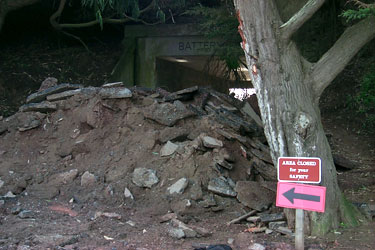
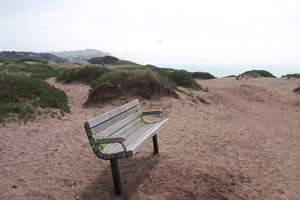
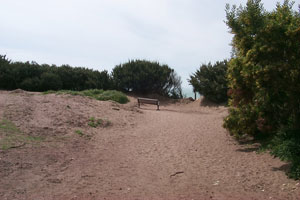
Now, and only thanks to strong protests a few weeks ago, the Sunset Trail is said to be "open" -- with new benches, which weren't needed -- but it's not open to most people who use wheelchairs or strollers, because of the uneven surface and deep sand.


Sunset on the Sunset Trail, March 29, 2000.
see also: Comments at GGNRA Advisory Commission meeting 3/21/2000
-- especially those of John Cranshaw, Jeff Ward & Florence Sarrett.
Special Notice
ACCESS FOR EVERYONE!
The entire contents of the above section on the Sunset Trail (with spoken text and text descriptions of each photograph) are accessible to blind and visually impaired people by using the IBM Home Page Reader (or other similar products.) Even if you're not visually impaired, you might find it interesting to listen to this entire page with your eyes closed. You can download a free 30-day trial of the program at:
http://www-3.ibm.com/able/hpr.htm
It uses Netscape Navigator (a part of Communicator) as your default browser, although you can still use Microsoft's Internet Explorer when not browsing with the IBM Home Page Reader.
Netscape's browser is also free, it's at:
http://www.netcenter.com/computing/download/index.html?cp=hom03x4
Please spread the word to people who could use these programs to browse the Web.
Also, please send feedback on using the IBM talking browser, whether or not you are visually impaired. Feel free to e-mail with questions about setting these programs up on your computer. I am trying to get feedback from people using them. Thank you. - Michael
For information on making your site accessible to all, visit: Center for Applied Special Technology (CAST): http://www.cast.org/
To find out about a website for yourself, your business or dog, please inquire.
... and now we return to our regularly scheduled program...
The Bureau That Cried Wolf
A Funston Fable
Once upon a time, there was a big bureaucracy that was in the habit of doing just whatever it felt like. The big bureaucracy didn't like having to tell anybody, even the people who loved to come visit it all the time, what it was going to do. But even the big bureaucracy had to sometimes appear to follow the law, so from time to time when its actions were hard to explain, it began to yell at everyone who would listen, "Emergency!" At first, everyone was very careful to heed these warnings of the big bureaucracy, even when its actions didn't seem to make sense. Surely, they reasoned, in an Emergency! everyone ought to listen to the warning and do exactly as they were told. But, as time went on, there kept being more and more Emergencies! One time, a road with just a teensy-weensy spot that needed to be fixed, was ripped out of the ground from one end to the other! Nobody knew why this happened, and it was said that the road was going to be closed for ever and ever. The people who loved to come visit knew that road, and they could not see any kind of Emergency! about it or why it should be torn out and closed. They began to talk amongst themselves, and even began thinking for themselves based on things they saw with their own eyes! "Sometimes when the big bureaucracy shouts out, 'Emergency!', it's just saying that; it doesn't really mean it!," said one of the visitors. Another replied, "It can't be bothered to explain itself all the time, it's a big bureaucracy!" Every year in the springtime, a colony of bank swallows would fly thousands of miles north to have their babies at the place where the people loved to visit. Even though everyone knew this was going to happen in the springtime, some people whispered that the big bureaucracy was going to shout, "Emergency!" when the swallows arrived. Then it would be able to keep all the people far, far away from the swallows who came back every year to where the people also came to visit. After a while, nobody even paid any attention when they heard someone shouting, "Emergency!" That was a very bad thing, because once in a very long while, at the place where the people and the birds loved to come visit, a very real and scary emergency would indeed happen. The people should have listened to the big bureaucracy at those rare times, and been very careful to do do as they were told. But it was too late. By that time, nobody would even turn around when they heard the word, "Emergency!"
by Michael B. Goldstein
How's the weather at Fort Funston? Know before you go!

Web cam, Wind & Temperature! and, support the web cam!
Closed. Permanently.
It made me very sad when they closed off that section. That has been my hill for 20 years. My dog Seva's ashes were scattered on that hill. We would all meet there on weekends, drink coffee and let our dogs run up & down the hill. The wind did a great deal of damage to that section. More than the dogs could ever do. It is hard to explain to a dog why they can't go to a place they have gone every day to. My Gaylan stands and looks at the fence with her kong in her mouth. Then she looks at me expecting me to open up the fence so she can go up on her hill. That was her favorite spot, she would hide behind one of the little dunes and wait for maya, then they would run in circles. SAD,SAD,SAD. We had some great times on that hill, I shall miss it. - Lee Walker
The end of the road. Hang a left, over the rolling dunes, a quick dash down to the beach, left again and loop back along the beach, left once more and climb up to the road, turn right and head back to the car, rejuvenated. For years, a routine that was anything but. And it's history. Reality sinks in slowly -- first the posts, but no fence. Then the wire mesh, but no gates. Suddenly, a second fence, marching quickly across a valley and tearing up a majestic dune, anchored in the very sand into which it was said a fence could not be planted. Still not real, somehow -- still legal to walk through the posts where the gates are not yet in. Then, with one stretch of metal across a few feet, it's over. Step in there and get a ticket. We didn't hurt anything on that dune. Left nothing, took nothing, trampled on nothing. What about consensus, process -- what about the law that requires notice and hearings, and what about the science that would determine if the stated goals will even be achieved with the action being taken? Who decided, when and where and why, that this area was to be permanently closed, turned into a nursery into which selected people would be permitted access, to come and plant certain plants while ripping out others? Where is it written that the bank swallows need a huge setback area from the cliffs to which they keep coming back, despite (because of?) human and dog activity? And if they indeed have moved from their prior spot, a large tract of public land, then why has that region remained off limits? And why does another area remain closed, five years after being closed for replanting which never happened? And where is the proof that seasonally fencing people off yet a fourth parcel of public recreation land, any day now, is justified? - Michael B. Goldstein
Demonstration outside, comments inside, at GGNRA Advisory Commission Meeting, Fort Mason Tue. March 21
|
To PRINT the comments below, click here
for page with nothing else. It may take a minute or two to load
and appear on your screen, then print it.
|
|
Golden Gate National Recreation Area, Advisory Commission Meeting March 21, 2000, Fort Mason, Bldg. 201 |
| Transcript from audiotape of public comments regarding Fort Funston (transcribed by, please send comments, questions, & corrections to: Michael B. Goldstein ) |
| (very brief portions of the audiotape that could not be understood after repeated playing are shown as: .......... ; in no case does this change the overall meaning of the statement involved, and the missing sections are never more than a few words in length) |
| 7:30 p.m. - Meeting called to order.
Eight agenda items were discussed. 11:17 p.m. - Beginning of comment period on non-agenda items: |
|
Andrea O'Leary: I guess I'm here basically to say that I think it's really important that we take a really good and long look at the whole context of sacred places. I grew up on a ranch in New Mexico of thousands and thousands of acres but yet there were sacred places on all... this land -- one family, lots of land, there are sacred places. And it was because my great grandfather, my grandfather, my father, and now my brothers, knew that these areas were so special and had such wonderful creatures on them, that they had to be preserved. And I still plan my trips home at certain times of the year so that I can tip-toe through those areas, at those given times when we're allowed to, because there are special species: quail, vertebrates, invertebrates, and creepy-crawlers, that you basically cannot find anywhere else, and this is in the middle of nowhere, in New Mexico. And I think that people tend to forget that we do have even those sacred places here in this urban environment. I've spent a long time trying, volunteering, going out with people from San Francisco State and other places, just to see what kind of creepy-crawlers have come back. And so I see for myself with my novice eyes, a lot of the creatures that are falling away, little insignificant little creatures, simply because we are running them out, we are stomping them into the ground. I can tell you areas where lots of dog activity does not happen where there are a lot of these creatures coming back, slowly, and there are others areas where you just, year after year, you just don't find them anymore. So that, there are places that are inappropriate for lots of dog activity, for lots of people activity, for activity that is going to, indeed, ....... over these very precious creatures. So Fort Funston isn't any different than any other place in the middle of San Francisco, Mount Davidson, ........., anywhere else, or in the middle of New Mexico. Thank you.
John Cranshaw: I'll make this very quick. First of all, I want to say thank you very much. I'm a longtime San Francisco resident and a physician, and I'm here to speak... to Fort Funston as well, particularly with regard to two issues: one is access, the other is process. I care for approximately 40 chronically ill, wheelchair-bound patients. The facility where I work endeavors to provide these patients opportunities for outdoor recreation, and there are few areas in San Francisco accessible to these patients. Fort Funston is one such area, and the recent removal of the paving in the Sunset Path area makes this area inaccessible to my patients, as well as to other sick persons. I would request this committee, if at all possible, to request that the GGNRA -- that they re-pave that. The decision to close the Sunset Trail, ostensibly for safety reasons, only to re-open it, in worse condition than before, I believe highlights major problems in the decision-making process that goes on at Fort Funston. This has repeated itself many times, over the years, whereby, instead of consulting with the affected parties before plans have been implemented, the GGNRA implements the plans, then a controversy develops -- in this case a lawsuit develops -- and then some or all of the actions that the GGNRA has taken have to be reversed. This is in nobody's interest. I would submit that by excluding the participation of the majority of individuals who actually visit Fort Funston, the GGNRA has set the stage for continued acrimony and legal......, which is not in your interest, not in my interest, is not in anyone's interest. I would request that you work with, rather than against, those who use Fort Funston, so that it can remain the beautiful, multi-use area, that it has always been. Thank you very much.
Linda Shore: Thank you, members of the commission, members of the public. My name is Linda Shore and I'm a native San Franciscan. I'm also here to speak about the controversy at Fort Funston. The parks that made up the GGNRA have been an important part of my life for over 40 years now. I literally took my first steps at Crissy Field, and I walk my dog every day at Fort Funston. By the way, I also generously contribute to the Audubon Society and to native plant conservation efforts. Let me say then that the controversy at Fort Funston is not about dogs, it's not about birds, it's not about native plants. It's about people. It's about the manner in which the GGNRA makes its decisions, and about how these decisions impact people. And it's about how people are forced to react when their needs are ignored and all avenues for input are literally closed off. The people you see here tonight -- those who are left! -- and the people you saw outside when you came in, represent just a small fraction of the number of people profoundly hurt by the decisions made to close certain areas of Fort Funston. We love Fort Funston because it's an integral part of our lives. When the fences went up, people got frightened -- I got frightened. We watched helplessly as an important part of our lives was literally stripped from us. And while the closures represent a very small, albeit extremely popular part of Fort Funston, we have absolutely no idea how these decisions were made, whether these decisions were grounded in sound scientific research, and more importantly, we have no idea where it will ultimately end. I submit that when the GGNRA makes decisions in secret, unilaterally, and without meaningful input from the public, you get what you're seeing now: rumors are generated and propagated, conspiracy is seen everywhere, factions become more polarized, and positions become entrenched. Surely no one's interests -- not the dogs, the swallows, the plants, or even the GGNRA, are served when this happens. I urge this advisory board take action to fundamentally change the way the GGNRA makes and carries out its decisions about the parks. Advise the GGNRA to make its intentions public. Tell them to hold open meetings. Include all stakeholders in the decision-making process, even those stakeholders you think you may not agree with. Doing anything less condemns the GGNRA and the public to do battle indefinitely. Thank you.
Rich Bartke, Advisory Commission Chair and meeting moderator: Before we go on, I'm going to do something I probably shouldn't do, but I want to remind people that this was on our agenda in January, a number of dogwalkers from Fort Funston did address us on that issue, that last month we extended another invitation to the leadership of the dogwalkers to get a formal spot on our agenda so they could speak to us on this issue, and that invitation has not been accepted. To say that we've been taking actions in secret is simply not fair. So let's talk about facts, how they actually happen.
Linda McKay: Hi, I'm Linda McKay. Thank you for listening to us so late in the evening. I want to correct a couple of points. I am a member of the Fort Funston Dog Walkers. We represent one of the factions that apparently was invited to get on your agenda, and, honestly, I never received an invitation. So there is a communication failure if you think you submitted an invitation to us; it was simply not known by our membership. We need to work on the communication. The other part I'd like to clarify is that we did have meetings, we've been meeting frequently with the GGNRA, on other issues. We had a walk-through in December of '98, we had a walk-through in December of '99, to talk about things like: we wanted to fund a water fountain, we need more garbage cans, you know, that kind of thing, and the bank swallow issue came up as a very peripheral discussion. We did not understand that our input was being elicited, we did not understand that it was a happening thing, we thought it was a submission of what might be. And at the meeting of January 18th was a "not for public comment" presentation by the GGNRA. So the decision had been made without our input. I think that's an important point. The second point I'd like to say is, I think there's more points of interest than there are of disinterest. I think with out input, and if we work with the factions that represent the other points of view, we could do a better job. What I brought is a color picture of what we call the "internal" fence. This fence is going to enclose the permanent enclosure, which completely closes off the valley that is very commonly used by recreational users. And I think that, had we worked together, we could have done a much better job on this; this is not attractive, and it doesn't do anyone any good. The third point I'd like to make is that we are asking for your help. We would like to have public hearings -- we think that we're entitled to it because we think that this was a major change in recreational use, and we think because of that, we were entitled to a hearing, with all groups present, with all facts at the table. And public comment at the end of your meeting at 11:30 at night is probably not the best way to hear us. ...
Anne Farrow: Good evening, although I think it's time to say goodnight, well, several hours ago! My name is Anne Farrow. I'm also here to address the closures at Fort Funston. I was at Fort Funston the day it opened as a San Francisco city park, October 29th, 1961. It was an open space to explore and enjoy. In 1972, my daughter and the GGNRA were born. The GGNRA was a vision of open space recreation for an urban population. It was a promise to keep that space open for recreation. The GGNRA has grown to more than 74,000 acres, now... 75,300 -- or soon to be, including Fort Funston. In 1995, my children were grown, and I started visiting Fort Funston on a daily basis with my dog. However, the vision had changed. Two large areas had been recently fenced, apparently without consulting park users. The promise had been broken. This year, 2000, a popular trail was destroyed, and a popular dune area was fenced. The fence is not only unpopular, but unnecessary. It's not designed to preserve and protect resources, a mandate in the scope of the National Park Service, but in fact has destroyed recreational resources, and is designed to create resources that probably never existed. Protecting the bank swallows on the cliffs, and protecting the occasional clueless visitor from the cliffs, would require a fence in a different location: near the cliff. The fence in its current location is visual pollution and is, well, offensive. Those of us who visit Fort Funston daily are in tune with the park. We're involved in its natural rhythms. We understand the weather, the erosion, the work of the tides, the storms. We respect the park. We keep the park clean, we police the park. We ask to be involved and included in the earliest phases of the decision-making process affecting the park. We want the vision back, and we want the promise kept. Thank you very much.
Jeff Ward: Good evening. Again, I'm here to speak about Fort Funston. My name is Jeff Ward. I'm one of the founding members of the San Francisco Dog Owners Group, a member of the Fort Funston Dog Walkers, author of the FreeDog website, and the proud alpha-male of three Weimaraners, age nine, four, and five months. But I don't want to talk about dogs, I want to talk about waste. And the waste that I want to talk about is the waste that occurs when we don't follow the process that we set down in law, with the inevitable results. And has been previously mentioned, one of those is the Sunset Trail. An area of about ten to fifteen feet of the paved trail was endangered by intrusive erosion -- a V-shaped cleft in the cliff structure -- and because of that, an area of approximately the size of PacBell Park was marked for closure. There was a great public outcry, as there was over the fences that have recently gone up, but that outcry, which resulted in the re-opening of that area, came too late: we had already destroyed the paved trail, we had taken out two benches, and we'd removed all garbage cans. Now, to make that usable again, you're going to have to re-pave the trail, put back the park benches that were a favorite whale-watching spot, and put back the garbage cans, at a cost to the taxpayers. So, I would put forward that the same process is going on in regarding the closure of the bank swallows. The San Francisco Dog Owners Group, for example, was never informed of that, although we have frequent contact with the GGNRA. As Linda pointed out, the Fort Funston Dog Walkers got involved very late in the game, when it was basically a fait accompli. At the meeting that I spoke at before, what we were responding to was not the request of input, but a plan that was being delivered to us... Now we've ended up in courts, which is a place that is a horrible use of my time, it's a horrible use of my money, it's a horrible use of the money of the organizations, the sad thing is, it's a horrible use of taxpayers' money. It could have been avoided if we had worked more closely together, if the people who walk dogs were considered part of the park constituency, instead of, as they are currently defined, criminals whose activity is simply not enforced. Thank you.
Laura Cavaluzzo : You've heard a lot tonight about what Fort Funston means to people of San Francisco, and about our frustration at being left out of the decision-making process on what we very rightly consider to be our land. But I have a slightly different perspective.... I don't own a car. So, while I love Fort Funston and I go there every chance I get, I most often recreate with my dogs in the city parks closer to home. And I'm here to talk a bit about the ramifications that sudden closures of popular GGNRA land like Fort Funston have on parks in neighborhoods throughout the entire city. San Francisco's Recreation and Parks Department has long been underfunded and understaffed. Recent ballot measures may solve those issues, however, there will always be a limited number of city park acres that recreationists of all kinds must share. Current estimates place the dog population of San Francisco at more than 100,000. Dog walking is among the most popular forms of recreation in the city, crossing all social strata, age groups, and differing levels of physical fitness and ability. Despite those facts, the facilities legally available to dog walkers are few and far between. Those legal dog areas that do exist are, in general, unmarked, unsafe, and poorly sited. This situation forces dog owners to seek out other areas to walk their dogs, leading, at times, to conflicts with other park users. Open spaces like Ocean Beach, Crissy Field and Fort Funston act as safety valves, allowing park users to spread out a bit, relieving the pressure on city parks and reducing conflict all over the city. When these areas are closed, with little warning, no request for public input and no cooperative sign in place to accomodate the displaced park users, city parks suffer greatly. And it's important to remember, too, that GGNRA land is not the only park in which delicate, threatened species live. Compressing park-goers into city parks increases the threat to the plants and animals there. As a daily user of San Francisco city parks and a frequent user of GGNRA lands, I ... prevail upon the GGNRA to open lines of communication, as they are bound by law to do. These park lands do not exist in a vacuum. ... they are urban parks, and our tax dollars pay for their upkeep. We have much to contribute to a meaningful dialog on how they should be used. Thank you.
Lindsay Kefauver: Good evening, commissioners. My name is Lindsay Kefauver, and I'm a regular user of Fort Funston. I've been walking there for 22 years. I wanted to address the citizens' Advisory Commission, because part of your mandate is to act as a watchdog over the National Park Service's management of the first urban park of its kind, the GGNRA. Fort Funston is a special place ..... for many residents of San Francisco and San Mateo counties. It is the place you look forward to going at the end of the day, to unwind and re-energize. We show it off to our out of town friends, family, who always remember being taken there and ask to go back. It is a glorious space which attracts many outdoor activities, all of us have co-existed very nicely, until the National Park Service started closing off large coastal areas to all users, and drastically reducing the available open space. If you're not familiar with the layout of Fort Funston, or haven't been there recently, I've brought a map, which I'm sure you wish I didn't, because everyone is bleary-eyed at this time, but I just would pass it around and, basically, I just wanted to show you what's happened. In1995, this area (green) and this area [pointing to map]were closed off without any public hearing or notice, for the bank swallow habitat and for the planting of native plants. We accepted this closure, because most of us who come to Fort Funston feel that we're environmentalists, and want to help reserve the bank swallow habitat. The other section closed off in 1995 ........ this section was supposed to be closed temporarily, for native plants. The plants never happened. Five years later, the area remains closed. At the end of last year, again without any public notice, or hearing, the National Park Service abruptly closed the Sunset Trail, and subsequently removed the asphalt pavement from the trail. It's a flat, paved trail with gorgeous ocean views, favored by the elderly, the disabled, and parents with babies in strollers. Now this trail has been re-opened, but it's a sand trail, and it's not paved. And then early this year came the latest land grab. This doesn't look like a lot of land, but it's a particularly popular dune play area for kids and dogs. The new closures are for protection of the bank swallows, who nest in the middle of the cliff face, and, even though a spokesperson agreed that the birds' habitat would be protected with just closing off the cliff edge, the National Park Service decided that the fences had to come all the way to the road, since they couldn't sink the posts in the sand -- and yet, they succeeded in installing a good stretch of fence across the dunes without any problem. The new enclosure resembles a stockade, except everyone is fenced out, and now we're just waiting for the sentries to take up their posts. We are anxious to find a happy compromise: we ask that the new fencing be moved back, to approximately 30 feet from the cliff edge, making this stretch of cliff a permanent closure for the birds; we'd like the five-year old "temporary" Battery section re-opened, and we would want the Sunset Trail re-paved and the benches returned. Thank you very much for your time.
Florence Sarrett: Thank you for your long patience. I will be very brief. I think you've probably noticed some of us are wearing this shirt, that says on it: Fort Fun! Fort Fun, it used to be. Fort Fun, it is no longer. You only have to go to Fort Funston on any weekend to see the hundreds of visitors there, to recognize the huge need for recreation that exists in our community, so I'd like to emphasize that the GGNRA was created specifically as an urban recreation area -- as distinguished from a national park. I've grown old visiting Fort Funston, almost weekly, sometimes daily, since the 1960's, and I'm here on behalf of the seniors, and the disabled groups that go there, some with dogs and some without dogs, who enjoy the beauty, the vibrant activity, and the warm and caring community that has grown up there. I am one of them. Recently, the pavement of the Sunset Trail has been removed, and the benches removed, where one could stop and enjoy the view, or a rest if you needed to rest, and now, it's difficult for many of us to walk there, in the sand, and I would think it's probably impossible to maneuver a wheelchair. I urge you to insist that the GGNRA honor its mandate to offer our community maximum opportunities for recreation, and especially to give consideration to the needs of the elderly, and to observe the legal requirements of the Americans with Disabilities Act. Thank you for your patience.
Amy Meyer, Advisory Commission Vice-Chair: Rich, I would like to give Brian one opportunity just to say whatever I've ....., I think because Florence, who I have the greatest respect for and have known for 25 years... would you please, Brian, just state once again, that there's no difference between this national park in an urban area, and any other national park. It is not something different, it is not an urban recreation area.... Rich Bartke, Advisory Commission Chair and meeting moderator: Frankly, it is my intent that the staff not speak at all, because the matter is in court, but I think the point Amy made is correct; that, although some national parks are called recreation areas, some are called seashores, and some are called something else, the management of those is all in the same manual, and they all are managed in the same manner. There's no difference in management, no matter what the name is.
Florence Sarrett: Could I ask one favor, before I sit down? I noticed that the chair appointed a member of the commission to act as liaison with the .......... Doyle Drive group, and I would love to see an appointment of a similar nature, to liaison with the Fort Funston Dog Walkers and the San Francisco Dog Owners Group, I think it would save a great deal of controversy.
Rich Bartke, Advisory Commission Chair and meeting moderator: Yeah, OK, that might be a good idea, it's something we could maybe work on.
[ David Adams.. -- comments not related to Fort Funston ]
Vicki Tiernan: Good evening. I'd like to thank you for your patience, as others have. My name is Vicki Tiernan. I am with the San Francisco Dog Owners Group and am also a member of the Sierra Club. I would also like to speak about the closures at Fort Funston. I'll keep this short, because others have already said a lot of what I had planned to say. To summarize, the important thing is that there were no public meetings held before the closure, and we were not included in the process of input. I'd also like to emphasize that this is a densely populated urban area. It's not the Grand Tetons. We are limited as to green space. We don't have the luxury of unlimited space here, and if, in the manual, there's no differentiation between management of an urban park and a national park, perhaps that should be looked into and changed, because this is an important consideration in this area. As Laura Cavaluzzo mentioned, there are an estimated 100,000 dogs in San Francisco, and I can pretty much assure you that every one of them loves Fort Funston! And so do the people who share their lives with them. It's a wonderful place and has been a cherished recreational area for a very long time. We're very upset about the fact that land keeps being taken away bit by bit -- it almost feels as if, eventually the whole Fort is going to be roped off and put under plastic furniture covers and no one is going to be able to enjoy it. We would like to see the bank swallows protected, certainly, but does it have to be done by taking away such a large amount of space? Do we have to have other habitat areas where no dogs or people are allowed, especially the area set aside for native plants in 1995 that has since been abandoned? I'd like to ask that all of this be reconsidered.
Pete Holloran: Pete Holloran , California Native Plant Society. We are very much in support of this administrative closure; it's no different from a city park closing a grassy lawn that has been damaged by added use. At the same time, we would really like to support comprehensive planning at Fort Funston. There is a need for more public input about all of the various resources at Funston. The demographic problem of having a hundred thousand dogs in San Francisco is a large social problem, and Fort Funston cannot bear the brunt of it. So I urge you to stand by the closure....
Tom Fulton: (?) Thank you. I'd like to commend the GGNRA and the members of the commission for their efforts to preserve bank swallows, native plants, and other priceless environmental features which have no other place to be. I would like to remind members ..... that dog owners represent a small, only a small, but strident, segment of the overall constituency that is served by the GGNRA, and I would urge you not to be held hostage...... I would just say that it is not the responsibility of the commission or the GGNRA to provide dog owners with dog runs at any location they desire. That we do have .... to endorse policies which promote the health, the safety, environmental and aesthetic concerns of all the hundreds of thousands of people, most of them non dog owners, who use the GGNRA on a daily basis. I would also like to submit that..... the present policy on dogs within ...... GGNRA and the national seashore is, at least in my view, incoherent and unenforced. Let me give you at least a couple of examples. Ocean Beach, which is supposed to be off-limits in certain sections to dogs who aren't at least on a leash ...... I challenge you to go down at any hour of the day, and you'll see that. Crissy Field is now complete chaos, from my point of view.... unleashed dogs in that area are absolutely inconsistent with the safety ..... I would challenge the commission to walk through East Beach, which is where the windsurfers used to be, barefoot ...... this beach is used by ...... small children, and I don't think you will walk through there unscathed. Further afield: Tennessee Valley. There's not supposed to be dogs in the main section down at the beach -- that is routinely violated. I have never seen anyone cited for that. And further afield, at Abbot's Lagoon and up towards the National Seashore's Sculptured Beach, routinely, you see this, that people allow dogs off-leash, and nothing's done. Just in summary, first of all, I commend you for your present firm stand, and I hope you prevail in court, and I would urge you to come up with a coherent and enforceable policy which protects the rights of everyone at the GGNRA, and gives primary consideration to the role of the GGRNA as a national park. Thank you.
Doug Kern (sp?): Good evening, my name is Doug Kern (sp?). I would like to first express my gratitude to those dogwalkers that are respectful of the open space, that are good stewards of open space, and I think that many, many dogwalkers are doing that. I'm a public person, I believe very much in the open, public process, so I'm also sympathetic to concerns by the dogwalking community that they haven't been heard... however, I'm also deeply concerned about destruction of resources. I believe in mixed-use of these lands, but I want to see the resources protected and respected by the entire community. So, prior to this date, I have not really involved myself in the dog walking controversy, believing that dog walkers would police their own. But, evidently, there is a, small, perhaps unpoliced group, at Fort Funston who may be ruining it for the rest of the dog walking community. I did investigate some of the laws: I have found the laws that say, for the National Park Service, "it is prohibited to fail to crate, cage, or restrain on a leash, or otherwise physically confine a pet at all times," so what this suggests to me is that because dogs are allowed off-leash, and to wander about these national park lands, that, there's been accomodation for the dog walking community, and I believe why the leadership has tried to accomodate the dog walking community. But, it seems to me that the accomodation is being abused. I think the Park Service may, in fact, be in violation of their own regulation. I strongly recommend that the dog walking community begin some sort of monitoring program for those members of your community who are giving it a difficult ...... for those people who would also like to see an area restored and protected. Thank you.
Charles Ryan: (?) I would like to say thank you to Brian O'Neill, for trying to protect the endangered species. We have to keep in mind that there is, quite certainly, no endangerment for domesticated animals. It is necessary to protect endangered species from domesticated canines, because the frank fact of the matter is, dogs scare the bejeezus out of....
Dan Murphy: My name is Dan Murphy, I represent the Golden Gate Audubon Society. Six thirty on Sunday morning, I took a walk at Fort Funston. I wanted to be there early, so I could experience what this park should be, and so that I could see what it is. I wanted to think about what I should say tonight. What I saw was disturbing. Where ice plant still dominates the dunes, there are great scars from intense off-trail use. I watched the dogs scrape great streamers of sand from the gusting wind. Once past the parking lot... at Battery Davis.... I was still walking ... towards the dunes. I took a path down to the dunes through the gulch at the north end of the restoration site some seem intent on blocking. On the beach, I felt the force of the wind and the sea, which have all but washed away traces of last year's bank swallow colony from the cliff face. I raced waves through the ... fortifications, which eroded through the sand bluffs onto the beach. One of them, by Panama Point, marks the place where the colony I watched for many hours back in 1980. The sand bluffs are scarred and worn. I find it hard to imagine that they did not erode three feet during the past winter. The bank swallows, which have historically nested along the entire bluff, from the gulch northward, will relocate their colony again this year. Back on Fort Funston terrace, I walked along the restored dunes and enjoyed a moment in this park as it should be enjoyed, where the dune community, which once dominated western San Francisco, at least is partly intact. I came finally to the dunes we've discussed here tonight, and, quite frankly, I'm surprised they haven't been closed earlier. They show marks of more erosion, and more abuse, than anywhere at Fort Funston. The steep slopes are bare of vegetation from human use .... In those places, the dunes which rest atop them are not just eroding from the sea inland, but from the land toward the sea, as well. Those dunes are a landscape being consumed, without the least regard for what the future generations will find there. There is nothing which can or should be done to curtail natural erosion at the site; there is much which should be done to reduce human impacts, which are not only threatening the bank swallow colony, but devastating this unit of our national recreation area. The Golden Gate Audubon Society supports your efforts to preserve Fort Funston for bank swallows, for habitat restoration, and for future generations.
Rich Bartke, Advisory Commission Chair and meeting moderator: Thank you. I want to thank everybody that took part this evening. It is late, and we're sorry about that, but I think you all treated each other with respect, and were quite concise and articulate in what you wanted to say to us. Unfortunately, our staff cannot respond because of the lawsuit that is going on, and there's really not a lot that the commission might do, because of the lawsuit. We anticipate, of course, that it will be resolved, sooner or later, but in the meantime, I appreciate the recommendation that this commission have some liaison with not only the Fort Funston Dog Walkers, but with other members of the dog walking community. We have had that in the past, but it has not been active in the last year or so, and it's a good suggestion... |
|
12:15 a.m., Wed. March 22 - Meeting adjourned. |
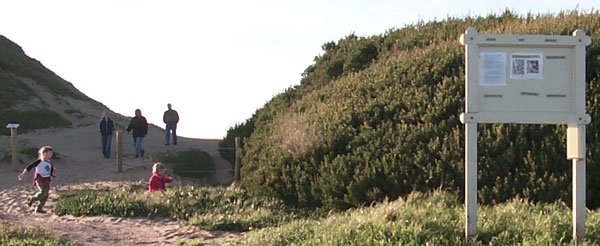
This sign and maps were posted during March 2000 on a new board next to the then still-open gate to the "seasonal" closure area.
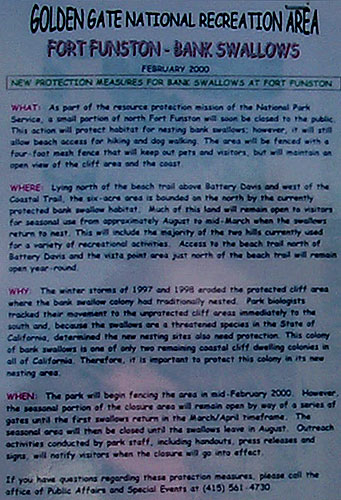 Golden
Gate National Recreation Area
Golden
Gate National Recreation Area Fort Funston - Bank Swallows February 2000
New Protection Measures for Bank Swallows at Fort Funston
WHAT: As part of the resource protection mission of the National Park Service, a small portion of north Fort Funston will soon be closed to the public. This action will protect habitat for nesting bank swallows; however it will still allow beach access for hiking and dog walking. The area will be fenced with a four-foot mesh fence that will keep out pets and visitors, but will maintain an open view of the cliff area and the coast.
WHERE: Lying north of the beach trail above Battery Davis and west of the Coastal Trail, the six-acre area is bounded on the north by the currently protected bank swallow habitat. Much of this land will remain open to visitors for seasonal use from approximately August to mid-March when the swallows return to nest. This will include the majority of the two hills currently used for a variety of recreational activities. Access to the beach trail north of Battery Davis and the vista point area just north of the beach trail will remain open year-round.
WHY: The winter storms of 1997 and 1998 eroded the protected cliff area where the bank swallow colony had traditionally nested. Park biologists tracked their movement to the unprotected cliff areas immediately to the south and, because the swallows are a threatened species in the State of California, determined the new nesting sites also need protection. This colony of bank swallow is one of only two remaining coastal cliff dwelling colonies in all of California. Therefore, it is important to protect the colony in its new nesting area.
WHEN: The park will begin fencing the area in mid-February 2000. However, the seasonal portion of the closure area will remain open by way of a series of gates until the first swallows return in the March/April timeframe. The seasonal area will then be closed until the swallows leave in August. Outreach activities conducted by park staff, including handouts, press releases and signs, will notify visitors when the closure will go into effect.
If you have questions regarding these protection measures, please call the office of Public Affairs and Special Events at (415) 561-4730.

Fort Fenced-In
Everything at Fort Funston -- in the Golden Gate National Recreation Area (GGNRA)-- in both photographs below (except the distant beach) has just been fenced off and is being closed to public access and recreation by the National Park Service. The areas to the left of the brand-new fence, itself a shameful violation of a pristine sand dune, are permanently closed. The areas to the right are seasonally closed five months a year.
Where is the science justifying these closures? Why was there an end-run around the legally required notice, publication and opportunity for comment at hearings? Why is the GGNRA closing off one area after another, for purposes that are not clearly needed, effective, nor consistent with the agency's mission of providing recreational opportunities?

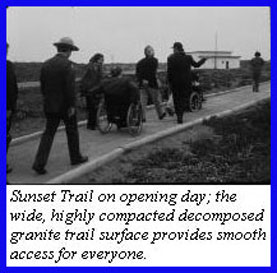
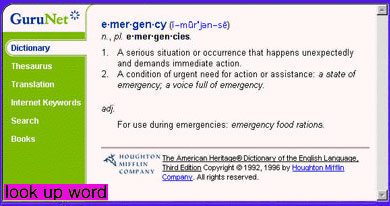

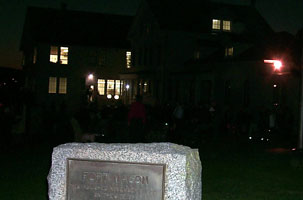
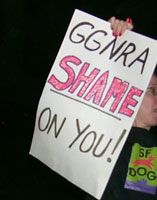
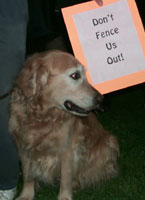

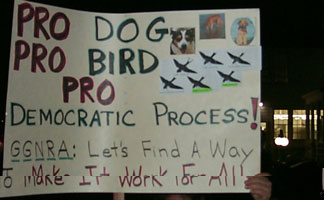
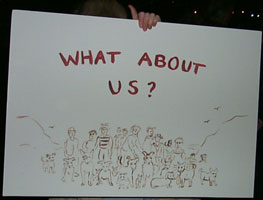


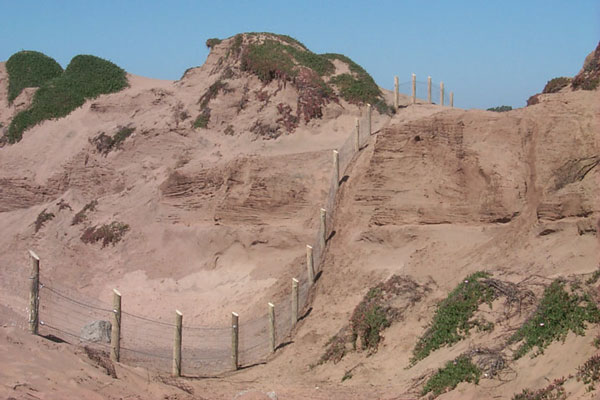
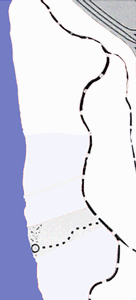
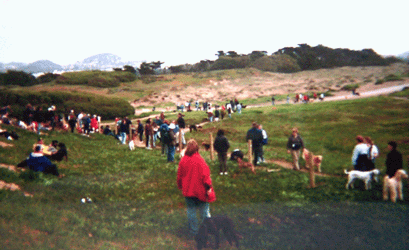 photo
by Elaine Best
photo
by Elaine Best
